|
SNAP Library 2.2, Developer Reference
2014-03-11 19:15:55
SNAP, a general purpose, high performance system for analysis and manipulation of large networks
|
|
SNAP Library 2.2, Developer Reference
2014-03-11 19:15:55
SNAP, a general purpose, high performance system for analysis and manipulation of large networks
|
#include <agmattr.h>
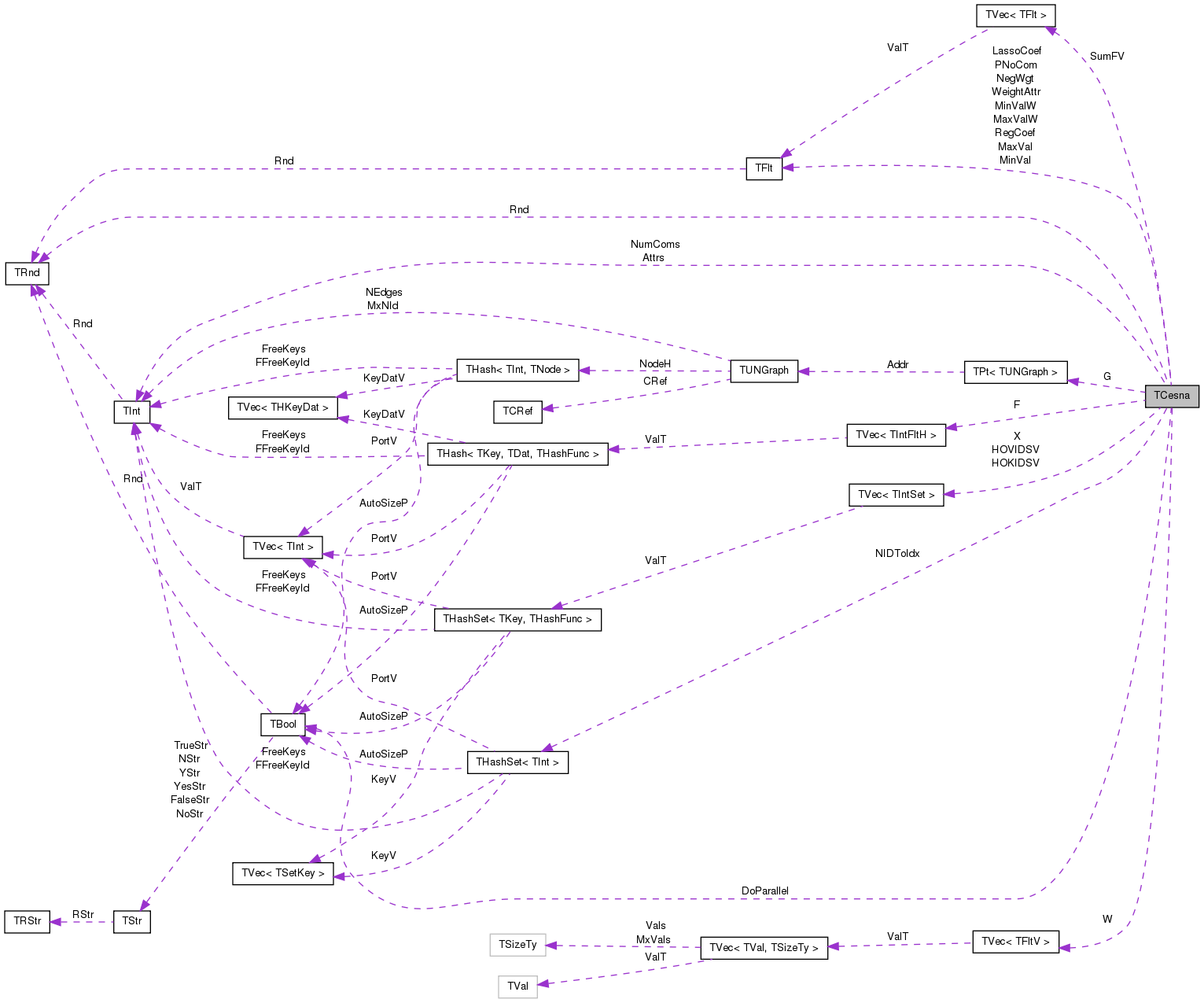
Public Member Functions | |
| TCesna () | |
| TCesna (const PUNGraph &GraphPt, const THash< TInt, TIntV > &NIDAttrH, const int &InitComs, const int RndSeed=0) | |
| void | Save (TSOut &SOut) |
| void | Load (TSIn &SIn, const int &RndSeed=0) |
| void | SetGraph (const PUNGraph &GraphPt, const THash< TInt, TIntV > &NIDAttrH) |
| void | SetRegCoef (const double _RegCoef) |
| double | GetRegCoef () |
| void | SetWeightAttr (const double _WeightAttr) |
| double | GetWeightAttr () |
| void | SetLassoCoef (const double _LassoCoef) |
| int | GetAttrs () |
| double | GetComFromNID (const int &NID, const int &CID) |
| double | GetLassoCoef () |
| void | InitW () |
| void | SetAttrHoldOut (const int NID, const int KID) |
| void | SetAttrHoldOutForOneNode (const int NID) |
| void | GetW (TVec< TFltV > &_W) |
| void | SetW (TVec< TFltV > &_W) |
| void | RandomInit (const int InitComs) |
| void | NeighborComInit (const int InitComs) |
| void | NeighborComInit (TFltIntPrV &NIdPhiV, const int InitComs) |
| int | GetNumComs () |
| void | SetCmtyVV (const TVec< TIntV > &CmtyVV) |
| double | Likelihood (const bool DoParallel=false) |
| double | LikelihoodForRow (const int UID) |
| double | LikelihoodForRow (const int UID, const TIntFltH &FU) |
| double | LikelihoodAttrKForRow (const int UID, const int K) |
| double | LikelihoodAttrKForRow (const int UID, const int K, const TIntFltH &FU) |
| double | LikelihoodAttrKForRow (const int UID, const int K, const TIntFltH &FU, const TFltV &WK) |
| double | LikelihoodForWK (const int K, const TFltV &WK) |
| double | LikelihoodForWK (const int K) |
| double | LikelihoodAttr () |
| double | LikelihoodGraph () |
| void | GenHoldOutAttr (const double HOFrac, TVec< TIntSet > &HOSetV) |
| void | SetHoldOut (const double HOFrac) |
| void | GradientForRow (const int UID, TIntFltH &GradU, const TIntSet &CIDSet) |
| void | GradientForWK (TFltV &GradV, const int K) |
| void | GetCmtyVV (TVec< TIntV > &CmtyVV) |
| void | GetCmtyVV (TVec< TIntV > &CmtyVV, TVec< TFltV > &Wck, const double Thres, const int MinSz=3) |
| extract community affiliation from F_uc Wck[c][k] = W_c for k-th attribute | |
| void | GetCmtyVV (TVec< TIntV > &CmtyVV, const double Thres, const int MinSz=3) |
| void | GetCmtyVV (TVec< TIntV > &CmtyVV, TVec< TFltV > &Wck) |
| void | GetCmtyVVUnSorted (TVec< TIntV > &CmtyVV) |
| void | GetCmtyVVUnSorted (TVec< TIntV > &CmtyVV, const double Thres, const int MinSz=3) |
| int | FindComs (TIntV &ComsV, const bool UseBIC=false, const double HOFrac=0.2, const int NumThreads=20, const TStr PlotLFNm=TStr(), const double StepAlpha=0.3, const double StepBeta=0.1) |
| int | FindComs (const int NumThreads, const int MaxComs, const int MinComs, const int DivComs, const TStr OutFNm, const bool UseBIC=false, const double HOFrac=0.1, const double StepAlpha=0.3, const double StepBeta=0.3) |
| estimate number of communities using cross validation | |
| void | DisplayAttrs (const int TopK, const TStrHash< TInt > &NodeNameH) |
| double | LikelihoodHoldOut () |
| double | GetStepSizeByLineSearch (const int UID, const TIntFltH &DeltaV, const TIntFltH &GradV, const double &Alpha, const double &Beta, const int MaxIter=10) |
| double | GetStepSizeByLineSearchForWK (const int K, const TFltV &DeltaV, const TFltV &GradV, const double &Alpha, const double &Beta, const int MaxIter=10) |
| int | GetPositiveW () |
| int | MLEGradAscent (const double &Thres, const int &MaxIter, const TStr PlotNm, const double StepAlpha=0.3, const double StepBeta=0.1) |
| int | MLEGradAscentParallel (const double &Thres, const int &MaxIter, const int ChunkNum, const int ChunkSize, const TStr PlotNm, const double StepAlpha=0.3, const double StepBeta=0.1) |
| int | MLEGradAscentParallel (const double &Thres, const int &MaxIter, const int ChunkNum, const TStr PlotNm=TStr(), const double StepAlpha=0.3, const double StepBeta=0.1) |
| double | GetCom (const int &NID, const int &CID) |
| double | GetAttr (const int &NID, const int &K) |
| void | AddCom (const int &NID, const int &CID, const double &Val) |
| void | DelCom (const int &NID, const int &CID) |
| double | DotProduct (const TIntFltH &UV, const TIntFltH &VV) |
| double | DotProduct (const int &UID, const int &VID) |
| double | Prediction (const TIntFltH &FU, const TIntFltH &FV) |
| double | PredictAttrK (const TIntFltH &FU, const TFltV &WK) |
| double | PredictAttrK (const TIntFltH &FU, const int K) |
| double | PredictAttrK (const int UID, const int K) |
| double | GetW (const int CID, const int K) |
| double | Prediction (const int &UID, const int &VID) |
| double | Sum (const TIntFltH &UV) |
| double | Norm2 (const TIntFltH &UV) |
| double | Sigmoid (const double X) |
Public Attributes | |
| TFlt | MinVal |
| TFlt | MaxVal |
| TFlt | MinValW |
| TFlt | MaxValW |
| TFlt | NegWgt |
| TFlt | LassoCoef |
| TFlt | WeightAttr |
| TFlt | PNoCom |
| TBool | DoParallel |
Private Attributes | |
| PUNGraph | G |
| TVec< TIntSet > | X |
| TVec< TIntFltH > | F |
| TVec< TFltV > | W |
| TInt | Attrs |
| TRnd | Rnd |
| TIntSet | NIDToIdx |
| TFlt | RegCoef |
| TFltV | SumFV |
| TInt | NumComs |
| TVec< TIntSet > | HOVIDSV |
| TVec< TIntSet > | HOKIDSV |
| TCesna::TCesna | ( | ) | [inline] |
Definition at line 268 of file agmattr.h.
References G, and TUNGraph::New().
{ G = TUNGraph::New(10, -1); }

| TCesna::TCesna | ( | const PUNGraph & | GraphPt, |
| const THash< TInt, TIntV > & | NIDAttrH, | ||
| const int & | InitComs, | ||
| const int | RndSeed = 0 |
||
| ) | [inline] |
Definition at line 269 of file agmattr.h.
References NeighborComInit(), and SetGraph().
: Rnd(RndSeed), RegCoef(0), MinVal(0.0), MaxVal(10.0), MinValW(-10.0), MaxValW(10.0), NegWgt(1.0), LassoCoef(1.0), WeightAttr(1.0) { SetGraph(GraphPt, NIDAttrH); NeighborComInit(InitComs); }
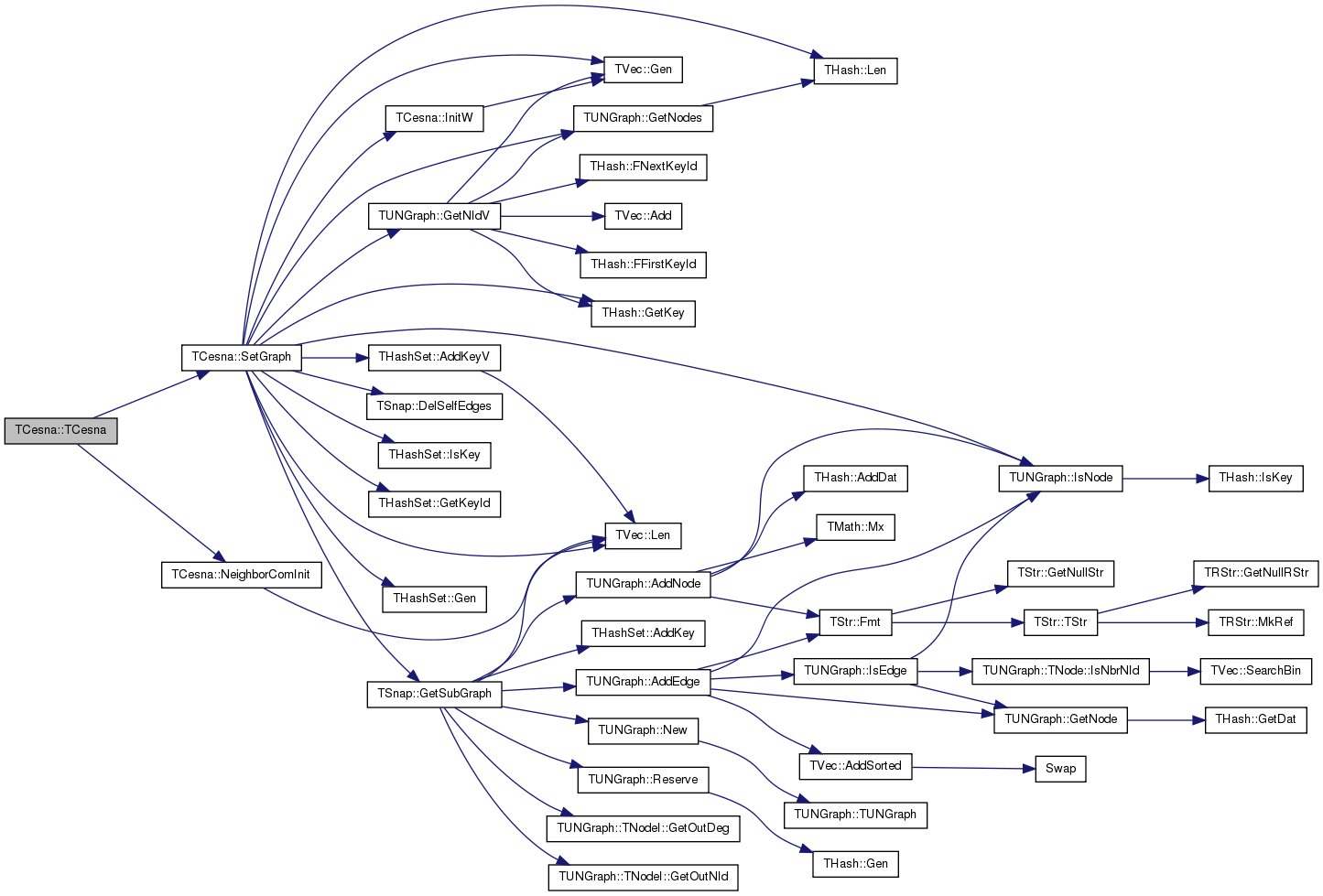
| void TCesna::AddCom | ( | const int & | NID, |
| const int & | CID, | ||
| const double & | Val | ||
| ) | [inline] |
Definition at line 538 of file agmattr.h.
References F, TVec< TVal, TSizeTy >::GetDat(), and SumFV.
Referenced by MLEGradAscent(), NeighborComInit(), RandomInit(), and SetCmtyVV().
{
if (F[NID].IsKey(CID)) {
SumFV[CID] -= F[NID].GetDat(CID);
}
F[NID].AddDat(CID) = Val;
SumFV[CID] += Val;
}


| void TCesna::DelCom | ( | const int & | NID, |
| const int & | CID | ||
| ) | [inline] |
Definition at line 546 of file agmattr.h.
References F, TVec< TVal, TSizeTy >::GetDat(), and SumFV.
Referenced by MLEGradAscent().


| void TCesna::DisplayAttrs | ( | const int | TopK, |
| const TStrHash< TInt > & | NodeNameH | ||
| ) | [inline] |
Definition at line 467 of file agmattr.h.
References TStrHash< TDat, TStringPool, THashFunc >::GetKey(), TVec< TVal, TSizeTy >::Len(), TStrHash< TDat, TStringPool, THashFunc >::Len(), NIDToIdx, and X.
{
for (int u = 0; u < X.Len(); u++) {
if (NodeNameH.Len() > 0) {
printf("NID: %s\t Attrs: ", NodeNameH.GetKey(NIDToIdx[u]));
} else {
printf("NID: %d\t Attrs: ", NIDToIdx[u].Val);
}
for (int k = 0; k < X[u].Len(); k++) {
printf("%d, ", X[u][k].Val);
}
printf("\n");
if (u >= TopK) { break; }
}
}

| double TCesna::DotProduct | ( | const TIntFltH & | UV, |
| const TIntFltH & | VV | ||
| ) | [inline] |
Definition at line 561 of file agmattr.h.
References THash< TKey, TDat, THashFunc >::BegI(), THash< TKey, TDat, THashFunc >::EndI(), THash< TKey, TDat, THashFunc >::GetDat(), THash< TKey, TDat, THashFunc >::IsKey(), and THash< TKey, TDat, THashFunc >::Len().
Referenced by DotProduct(), GetStepSizeByLineSearch(), GetStepSizeByLineSearchForWK(), LikelihoodForRow(), and Prediction().
{
double DP = 0;
if (UV.Len() > VV.Len()) {
for (TIntFltH::TIter HI = UV.BegI(); HI < UV.EndI(); HI++) {
if (VV.IsKey(HI.GetKey())) {
DP += VV.GetDat(HI.GetKey()) * HI.GetDat();
}
}
} else {
for (TIntFltH::TIter HI = VV.BegI(); HI < VV.EndI(); HI++) {
if (UV.IsKey(HI.GetKey())) {
DP += UV.GetDat(HI.GetKey()) * HI.GetDat();
}
}
}
return DP;
}
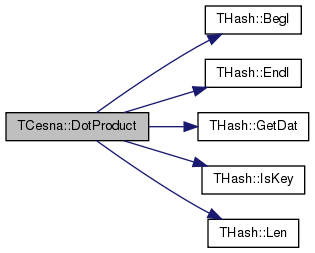

| double TCesna::DotProduct | ( | const int & | UID, |
| const int & | VID | ||
| ) | [inline] |
Definition at line 578 of file agmattr.h.
References DotProduct(), and F.
{
return DotProduct(F[UID], F[VID]);
}
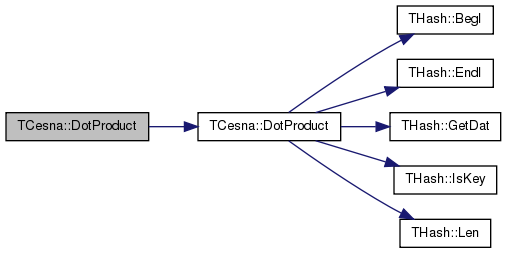
| int TCesna::FindComs | ( | TIntV & | ComsV, |
| const bool | UseBIC = false, |
||
| const double | HOFrac = 0.2, |
||
| const int | NumThreads = 20, |
||
| const TStr | PlotLFNm = TStr(), |
||
| const double | StepAlpha = 0.3, |
||
| const double | StepBeta = 0.1 |
||
| ) |
Definition at line 361 of file agmattr.cpp.
References TVec< TVal, TSizeTy >::Add(), Attrs, TStr::Empty(), G, TVec< TVal, TSizeTy >::Gen(), GenHoldOutAttr(), TCesnaUtil::GenHoldOutPairs(), TUNGraph::GetNodes(), HOKIDSV, HOVIDSV, TVec< TVal, TSizeTy >::Last(), TVec< TVal, TSizeTy >::Len(), Likelihood(), LikelihoodAttr(), LikelihoodHoldOut(), MLEGradAscent(), MLEGradAscentParallel(), TFlt::Mn, NeighborComInit(), TGnuPlot::PlotValV(), RandomInit(), Rnd, and WeightAttr.
Referenced by FindComs().
{
if (ComsV.Len() == 0) {
int MaxComs = G->GetNodes() / 5;
ComsV.Add(2);
while(ComsV.Last() < MaxComs) { ComsV.Add(ComsV.Last() * 2); }
}
int MaxIterCV = 3;
TVec<TVec<TIntSet> > HoldOutSets(MaxIterCV), HoldOutSetsAttr(MaxIterCV);
TFltIntPrV NIdPhiV;
TCesnaUtil::GetNIdPhiV<PUNGraph>(G, NIdPhiV);
if (! UseBIC) { //if edges are many enough, use CV
//printf("generating hold out set\n");
TIntV NIdV1, NIdV2;
G->GetNIdV(NIdV1);
G->GetNIdV(NIdV2);
for (int IterCV = 0; IterCV < MaxIterCV; IterCV++) {
// generate holdout sets
TCesnaUtil::GenHoldOutPairs(G, HoldOutSets[IterCV], HOFrac, Rnd);
GenHoldOutAttr(HOFrac, HoldOutSetsAttr[IterCV]);
}
//printf("hold out set generated\n");
}
TFltV HOLV(ComsV.Len());
TIntFltPrV ComsLV;
for (int c = 0; c < ComsV.Len(); c++) {
const int Coms = ComsV[c];
//printf("Try number of Coms:%d\n", Coms);
if (! UseBIC) { //if edges are many enough, use CV
for (int IterCV = 0; IterCV < MaxIterCV; IterCV++) {
HOVIDSV = HoldOutSets[IterCV];
HOKIDSV = HoldOutSetsAttr[IterCV];
NeighborComInit(NIdPhiV, Coms);
//printf("Initialized\n");
if (NumThreads == 1) {
//printf("MLE without parallelization begins\n");
MLEGradAscent(0.01, 100 * G->GetNodes(), "", StepAlpha, StepBeta);
//printf("likelihood: train:%f, attr:%f, hold:%f\n", Likelihood(), LikelihoodAttr(), LikelihoodHoldOut());
} else {
//printf("MLE with parallelization begins\n");
MLEGradAscentParallel(0.01, 100, NumThreads, "", StepAlpha, StepBeta);
}
double HOL = LikelihoodHoldOut();
HOL = HOL < 0? HOL: TFlt::Mn;
HOLV[c] += HOL;
}
}
else {
HOVIDSV.Gen(G->GetNodes());
HOKIDSV.Gen(G->GetNodes());
if (NumThreads == 1) {
MLEGradAscent(0.005, 100 * G->GetNodes(), "", StepAlpha, StepBeta);
printf("likelihood: train:%f, attr:%f, hold:%f\n", Likelihood(), LikelihoodAttr(), LikelihoodHoldOut());
} else {
MLEGradAscentParallel(0.005, 100, NumThreads, "", StepAlpha, StepBeta);
}
//int NumParams = G->GetNodes() * Coms + Coms * Attrs;
double NumParams = (1.0 - WeightAttr) * Coms + WeightAttr * Coms * Attrs;
double Observations = (1.0 - WeightAttr) * G->GetNodes() * (G->GetNodes() - 1) / 2 + WeightAttr * G->GetNodes() * Attrs;
double BIC = 2 * Likelihood() - NumParams * log (Observations);
HOLV[c] = BIC;
}
}
int EstComs = 2;
double MaxL = TFlt::Mn;
if (UseBIC) {
printf("Number of communities vs likelihood (criterion: BIC)\n");
} else {
printf("Number of communities vs likelihood (criterion: Cross validation)\n");
}
for (int c = 0; c < ComsV.Len(); c++) {
ComsLV.Add(TIntFltPr(ComsV[c].Val, HOLV[c].Val));
printf("%d(%f)\t", ComsV[c].Val, HOLV[c].Val);
if (MaxL < HOLV[c]) {
MaxL = HOLV[c];
EstComs = ComsV[c];
}
}
printf("\n");
RandomInit(EstComs);
HOVIDSV.Gen(G->GetNodes());
HOKIDSV.Gen(G->GetNodes());
if (! PlotLFNm.Empty()) {
TGnuPlot::PlotValV(ComsLV, PlotLFNm, "hold-out likelihood", "communities", "likelihood");
}
return EstComs;
}


| int TCesna::FindComs | ( | const int | NumThreads, |
| const int | MaxComs, | ||
| const int | MinComs, | ||
| const int | DivComs, | ||
| const TStr | OutFNm, | ||
| const bool | UseBIC = false, |
||
| const double | HOFrac = 0.1, |
||
| const double | StepAlpha = 0.3, |
||
| const double | StepBeta = 0.3 |
||
| ) |
estimate number of communities using cross validation
Definition at line 348 of file agmattr.cpp.
References TVec< TVal, TSizeTy >::Add(), FindComs(), TVec< TVal, TSizeTy >::Last(), TVec< TVal, TSizeTy >::Len(), TMath::Log(), and TInt::Val.
{
double ComsGap = exp(TMath::Log((double) MaxComs / (double) MinComs) / (double) DivComs);
TIntV ComsV;
ComsV.Add(MinComs);
while (ComsV.Len() < DivComs) {
int NewComs = int(ComsV.Last() * ComsGap);
if (NewComs == ComsV.Last().Val) { NewComs++; }
ComsV.Add(NewComs);
}
if (ComsV.Last() < MaxComs) { ComsV.Add(MaxComs); }
return FindComs(ComsV, UseBIC, HOFrac, NumThreads, OutFNm, StepAlpha, StepBeta);
}
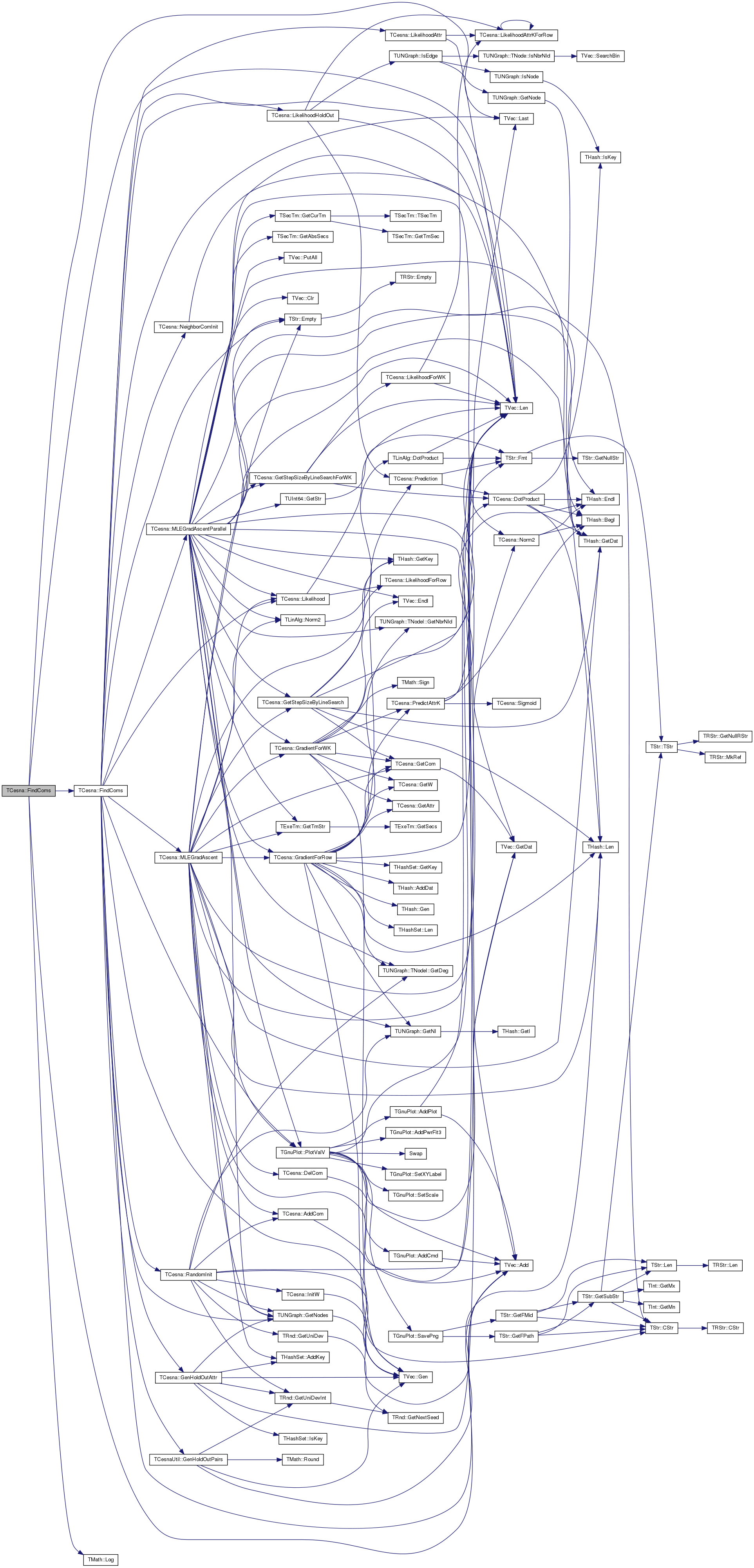
| void TCesna::GenHoldOutAttr | ( | const double | HOFrac, |
| TVec< TIntSet > & | HOSetV | ||
| ) | [inline] |
Definition at line 394 of file agmattr.h.
References THashSet< TKey, THashFunc >::AddKey(), Attrs, F, G, TVec< TVal, TSizeTy >::Gen(), TUNGraph::GetNodes(), TRnd::GetUniDevInt(), THashSet< TKey, THashFunc >::IsKey(), TVec< TVal, TSizeTy >::Len(), and Rnd.
Referenced by FindComs(), and SetHoldOut().
{
HOSetV.Gen(F.Len());
int HoldOutCnt = (int) ceil(HOFrac * G->GetNodes() * Attrs);
TIntPrSet NIDKIDSet(HoldOutCnt);
int Cnt = 0;
for (int h = 0; h < 10 * HoldOutCnt; h++) {
int UID = Rnd.GetUniDevInt(F.Len());
int KID = Rnd.GetUniDevInt(Attrs);
if (! NIDKIDSet.IsKey(TIntPr(UID, KID))) {
NIDKIDSet.AddKey(TIntPr(UID, KID));
HOSetV[UID].AddKey(KID);
Cnt++;
}
if (Cnt >= HoldOutCnt) { break; }
}
printf("%d hold out pairs generated for attributes\n", Cnt);
}
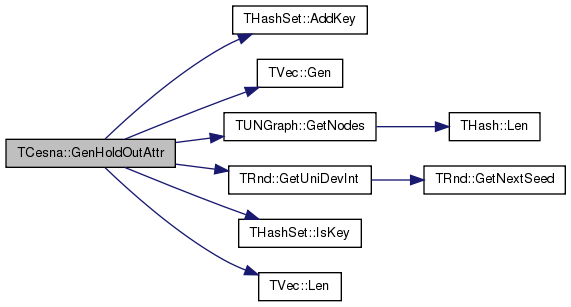

| double TCesna::GetAttr | ( | const int & | NID, |
| const int & | K | ||
| ) | [inline] |
Definition at line 531 of file agmattr.h.
References X.
Referenced by GradientForRow(), GradientForWK(), and LikelihoodAttrKForRow().
{
if (X[NID].IsKey(K)) {
return 1.0;
} else {
return 0.0;
}
}

| int TCesna::GetAttrs | ( | ) | [inline] |
| void TCesna::GetCmtyVV | ( | TVec< TIntV > & | CmtyVV | ) |
Definition at line 289 of file agmattr.cpp.
References G, TUNGraph::GetEdges(), and TUNGraph::GetNodes().
Referenced by GetCmtyVV().
{
TVec<TFltV> TmpV;
GetCmtyVV(CmtyVV, TmpV, sqrt(2.0 * (double) G->GetEdges() / G->GetNodes() / G->GetNodes()), 3);
}


| void TCesna::GetCmtyVV | ( | TVec< TIntV > & | CmtyVV, |
| TVec< TFltV > & | Wck, | ||
| const double | Thres, | ||
| const int | MinSz = 3 |
||
| ) |
extract community affiliation from F_uc Wck[c][k] = W_c for k-th attribute
Definition at line 296 of file agmattr.cpp.
References TVec< TVal, TSizeTy >::Add(), THash< TKey, TDat, THashFunc >::AddDat(), Attrs, F, TVec< TVal, TSizeTy >::Gen(), GetCom(), THash< TKey, TDat, THashFunc >::GetDat(), THash< TKey, TDat, THashFunc >::GetKey(), THashSet< TKey, THashFunc >::GetKeyV(), GetW(), IAssert, TVec< TVal, TSizeTy >::Len(), NIDToIdx, NumComs, THash< TKey, TDat, THashFunc >::SortByDat(), and SumFV.
{
CmtyVV.Gen(NumComs, 0);
Wck.Gen(NumComs, 0);
TIntFltH CIDSumFH(NumComs);
for (int c = 0; c < SumFV.Len(); c++) {
CIDSumFH.AddDat(c, SumFV[c]);
}
CIDSumFH.SortByDat(false);
for (int c = 0; c < NumComs; c++) {
int CID = CIDSumFH.GetKey(c);
TIntFltH NIDFucH(F.Len() / 10);
TIntV CmtyV;
IAssert(SumFV[CID] == CIDSumFH.GetDat(CID));
if (SumFV[CID] < Thres) { continue; }
for (int u = 0; u < F.Len(); u++) {
int NID = NIDToIdx[u];
if (GetCom(u, CID) >= Thres) { NIDFucH.AddDat(NID, GetCom(u, CID)); }
}
NIDFucH.SortByDat(false);
NIDFucH.GetKeyV(CmtyV);
if (CmtyV.Len() < MinSz) { continue; }
CmtyVV.Add(CmtyV);
TFltV WV(Attrs);
for (int k = 0; k < Attrs; k++) {
WV[k] = GetW(CID, k);
}
Wck.Add(WV);
}
if ( NumComs != CmtyVV.Len()) {
printf("Community vector generated. %d communities are ommitted\n", NumComs.Val - CmtyVV.Len());
}
}
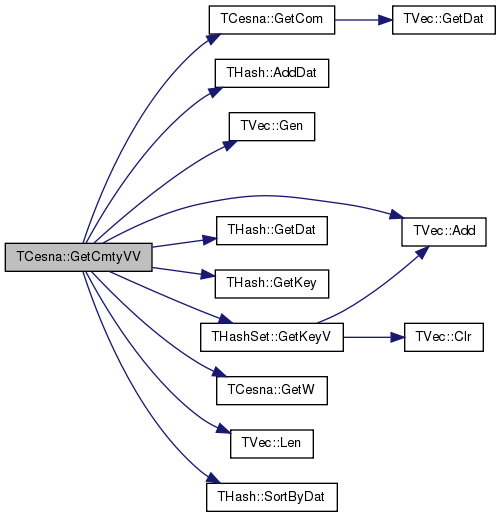
| void TCesna::GetCmtyVV | ( | TVec< TIntV > & | CmtyVV, |
| const double | Thres, | ||
| const int | MinSz = 3 |
||
| ) | [inline] |
Definition at line 435 of file agmattr.h.
References GetCmtyVV().
{
TVec<TFltV> TmpV;
GetCmtyVV(CmtyVV, TmpV, Thres, MinSz);
}

| void TCesna::GetCmtyVV | ( | TVec< TIntV > & | CmtyVV, |
| TVec< TFltV > & | Wck | ||
| ) | [inline] |
Definition at line 439 of file agmattr.h.
References G, GetCmtyVV(), TUNGraph::GetEdges(), and TUNGraph::GetNodes().

| void TCesna::GetCmtyVVUnSorted | ( | TVec< TIntV > & | CmtyVV | ) |
Definition at line 329 of file agmattr.cpp.
References G, TUNGraph::GetEdges(), and TUNGraph::GetNodes().
{
GetCmtyVVUnSorted(CmtyVV, sqrt(2.0 * (double) G->GetEdges() / G->GetNodes() / G->GetNodes()), 3);
}

| void TCesna::GetCmtyVVUnSorted | ( | TVec< TIntV > & | CmtyVV, |
| const double | Thres, | ||
| const int | MinSz = 3 |
||
| ) |
Definition at line 333 of file agmattr.cpp.
References TVec< TVal, TSizeTy >::Add(), G, TVec< TVal, TSizeTy >::Gen(), GetCom(), TUNGraph::GetNodes(), TVec< TVal, TSizeTy >::Len(), NIDToIdx, and NumComs.
{
CmtyVV.Gen(NumComs, 0);
for (int c = 0; c < NumComs; c++) {
TIntV CmtyV;
for (int u = 0; u < G->GetNodes(); u++) {
if (GetCom(u, c) > Thres) { CmtyV.Add(NIDToIdx[u]); }
}
if (CmtyV.Len() >= MinSz) { CmtyVV.Add(CmtyV); }
}
if ( NumComs != CmtyVV.Len()) {
printf("Community vector generated. %d communities are ommitted\n", NumComs.Val - CmtyVV.Len());
}
}

| double TCesna::GetCom | ( | const int & | NID, |
| const int & | CID | ||
| ) | [inline] |
Definition at line 524 of file agmattr.h.
References F, and TVec< TVal, TSizeTy >::GetDat().
Referenced by GetCmtyVV(), GetCmtyVVUnSorted(), GetStepSizeByLineSearch(), GradientForRow(), GradientForWK(), LikelihoodForRow(), and MLEGradAscent().


| double TCesna::GetComFromNID | ( | const int & | NID, |
| const int & | CID | ||
| ) | [inline] |
Definition at line 319 of file agmattr.h.
References F, TVec< TVal, TSizeTy >::GetDat(), THashSet< TKey, THashFunc >::GetKeyId(), and NIDToIdx.
{
int NIdx = NIDToIdx.GetKeyId(NID);
if (F[NIdx].IsKey(CID)) {
return F[NIdx].GetDat(CID);
} else {
return 0.0;
}
}

| double TCesna::GetLassoCoef | ( | ) | [inline] |
| int TCesna::GetNumComs | ( | ) | [inline] |
| int TCesna::GetPositiveW | ( | ) | [inline] |
| double TCesna::GetRegCoef | ( | ) | [inline] |
| double TCesna::GetStepSizeByLineSearch | ( | const int | UID, |
| const TIntFltH & | DeltaV, | ||
| const TIntFltH & | GradV, | ||
| const double & | Alpha, | ||
| const double & | Beta, | ||
| const int | MaxIter = 10 |
||
| ) |
Definition at line 480 of file agmattr.cpp.
References DotProduct(), GetCom(), THash< TKey, TDat, THashFunc >::GetDat(), THash< TKey, TDat, THashFunc >::GetKey(), THash< TKey, TDat, THashFunc >::Len(), LikelihoodForRow(), MaxVal, and MinVal.
Referenced by MLEGradAscent(), and MLEGradAscentParallel().
{
double StepSize = 1.0;
double InitLikelihood = LikelihoodForRow(UID);
TIntFltH NewVarV(DeltaV.Len());
for(int iter = 0; iter < MaxIter; iter++) {
for (int i = 0; i < DeltaV.Len(); i++){
int CID = DeltaV.GetKey(i);
double NewVal = GetCom(UID, CID) + StepSize * DeltaV.GetDat(CID);
if (NewVal < MinVal) { NewVal = MinVal; }
if (NewVal > MaxVal) { NewVal = MaxVal; }
NewVarV.AddDat(CID, NewVal);
}
if (LikelihoodForRow(UID, NewVarV) < InitLikelihood + Alpha * StepSize * DotProduct(GradV, DeltaV)) {
StepSize *= Beta;
} else {
break;
}
if (iter == MaxIter - 1) {
StepSize = 0.0;
break;
}
}
return StepSize;
}
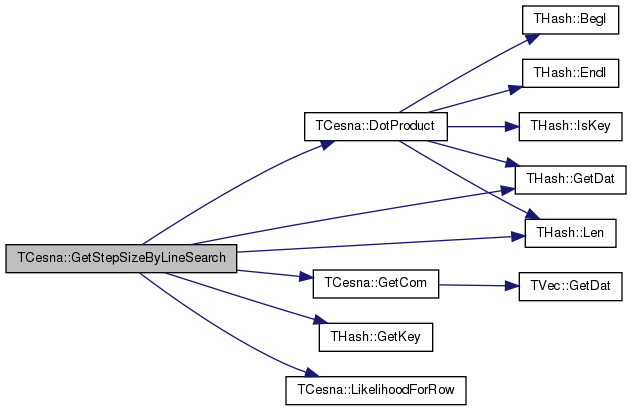

| double TCesna::GetStepSizeByLineSearchForWK | ( | const int | K, |
| const TFltV & | DeltaV, | ||
| const TFltV & | GradV, | ||
| const double & | Alpha, | ||
| const double & | Beta, | ||
| const int | MaxIter = 10 |
||
| ) | [inline] |
Definition at line 483 of file agmattr.h.
References DotProduct(), IAssert, TVec< TVal, TSizeTy >::Len(), LikelihoodForWK(), MaxValW, MinValW, NumComs, and W.
Referenced by MLEGradAscent(), and MLEGradAscentParallel().
{
double StepSize = 1.0;
double InitLikelihood = LikelihoodForWK(K);
TFltV NewVarV(DeltaV.Len());
IAssert(DeltaV.Len() == NumComs + 1);
for(int iter = 0; iter < MaxIter; iter++) {
for (int c = 0; c < DeltaV.Len(); c++){
double NewVal = W[K][c] + StepSize * DeltaV[c];
if (NewVal < MinValW) { NewVal = MinValW; }
if (NewVal > MaxValW) { NewVal = MaxValW; }
NewVarV[c] = NewVal;
}
if (LikelihoodForWK(K, NewVarV) < InitLikelihood + Alpha * StepSize * TLinAlg::DotProduct(GradV, DeltaV)) {
StepSize *= Beta;
} else {
break;
}
if (iter == MaxIter - 1) {
StepSize = 0.0;
break;
}
}
return StepSize;
}
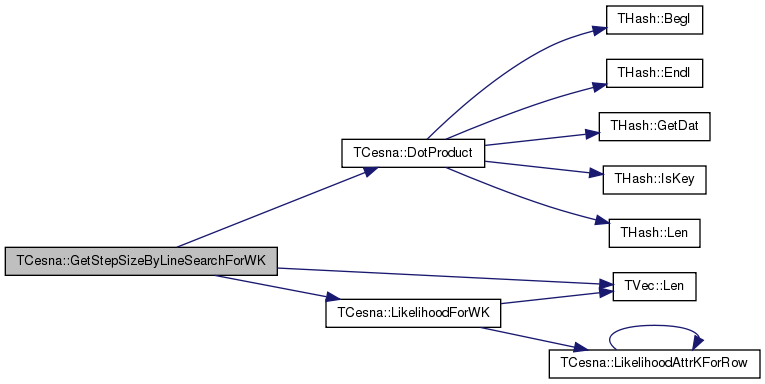

| void TCesna::GetW | ( | TVec< TFltV > & | _W | ) | [inline] |
Definition at line 343 of file agmattr.h.
References W.
Referenced by GetCmtyVV(), GetPositiveW(), GradientForRow(), and GradientForWK().
{ _W = W; }

| double TCesna::GetW | ( | const int | CID, |
| const int | K | ||
| ) | [inline] |
| double TCesna::GetWeightAttr | ( | ) | [inline] |
| void TCesna::GradientForRow | ( | const int | UID, |
| TIntFltH & | GradU, | ||
| const TIntSet & | CIDSet | ||
| ) |
Definition at line 213 of file agmattr.cpp.
References THash< TKey, TDat, THashFunc >::AddDat(), Attrs, F, G, THash< TKey, TDat, THashFunc >::Gen(), TVec< TVal, TSizeTy >::Gen(), GetAttr(), GetCom(), TUNGraph::TNodeI::GetDeg(), THashSet< TKey, THashFunc >::GetKey(), TUNGraph::TNodeI::GetNbrNId(), TUNGraph::GetNI(), GetW(), HOKIDSV, HOVIDSV, IAssert, THash< TKey, TDat, THashFunc >::Len(), TVec< TVal, TSizeTy >::Len(), THashSet< TKey, THashFunc >::Len(), NegWgt, PredictAttrK(), Prediction(), RegCoef, SumFV, W, and WeightAttr.
Referenced by MLEGradAscent(), and MLEGradAscentParallel().
{
GradU.Gen(CIDSet.Len());
TFltV HOSumFV; //adjust for Fv of v hold out
if (HOVIDSV[UID].Len() > 0) {
HOSumFV.Gen(SumFV.Len());
for (int e = 0; e < HOVIDSV[UID].Len(); e++) {
for (int c = 0; c < SumFV.Len(); c++) {
HOSumFV[c] += GetCom(HOVIDSV[UID][e], c);
}
}
}
TUNGraph::TNodeI NI = G->GetNI(UID);
int Deg = NI.GetDeg();
TFltV PredV(Deg), GradV(CIDSet.Len());
TIntV CIDV(CIDSet.Len());
for (int e = 0; e < Deg; e++) {
if (NI.GetNbrNId(e) == UID) { continue; }
if (HOVIDSV[UID].IsKey(NI.GetNbrNId(e))) { continue; }
PredV[e] = Prediction(UID, NI.GetNbrNId(e));
}
for (int c = 0; c < CIDSet.Len(); c++) {
int CID = CIDSet.GetKey(c);
double Val = 0.0;
for (int e = 0; e < Deg; e++) {
int VID = NI.GetNbrNId(e);
if (VID == UID) { continue; }
if (HOVIDSV[UID].IsKey(VID)) { continue; }
Val += PredV[e] * GetCom(VID, CID) / (1.0 - PredV[e]) + NegWgt * GetCom(VID, CID);
}
double HOSum = HOVIDSV[UID].Len() > 0? HOSumFV[CID].Val: 0.0;//subtract Hold out pairs only if hold out pairs exist
Val -= NegWgt * (SumFV[CID] - HOSum - GetCom(UID, CID));
CIDV[c] = CID;
GradV[c] = Val;
}
//add regularization
if (RegCoef > 0.0) { //L1
for (int c = 0; c < GradV.Len(); c++) {
GradV[c] -= RegCoef;
}
}
if (RegCoef < 0.0) { //L2
for (int c = 0; c < GradV.Len(); c++) {
GradV[c] += 2 * RegCoef * GetCom(UID, CIDV[c]);
}
}
for (int c = 0; c < GradV.Len(); c++) {
GradV[c] *= (1.0 - WeightAttr);
}
//add attribute part
TFltV AttrPredV(Attrs);
for (int k = 0; k < Attrs; k++) {
if (HOKIDSV[UID].IsKey(k)) { continue; }
AttrPredV[k] = PredictAttrK(F[UID], W[k]);
}
for (int c = 0; c < GradV.Len(); c++) {
for (int k = 0; k < Attrs; k++) {
if (HOKIDSV[UID].IsKey(k)) { continue; }
GradV[c] += WeightAttr * (GetAttr(UID, k) - AttrPredV[k]) * GetW(CIDV[c], k);
}
}
for (int c = 0; c < GradV.Len(); c++) {
if (GetCom(UID, CIDV[c]) == 0.0 && GradV[c] < 0.0) { continue; }
if (fabs(GradV[c]) < 0.0001) { continue; }
GradU.AddDat(CIDV[c], GradV[c]);
}
for (int c = 0; c < GradU.Len(); c++) {
if (GradU[c] >= 10) { GradU[c] = 10; }
if (GradU[c] <= -10) { GradU[c] = -10; }
IAssert(GradU[c] >= -10);
}
}
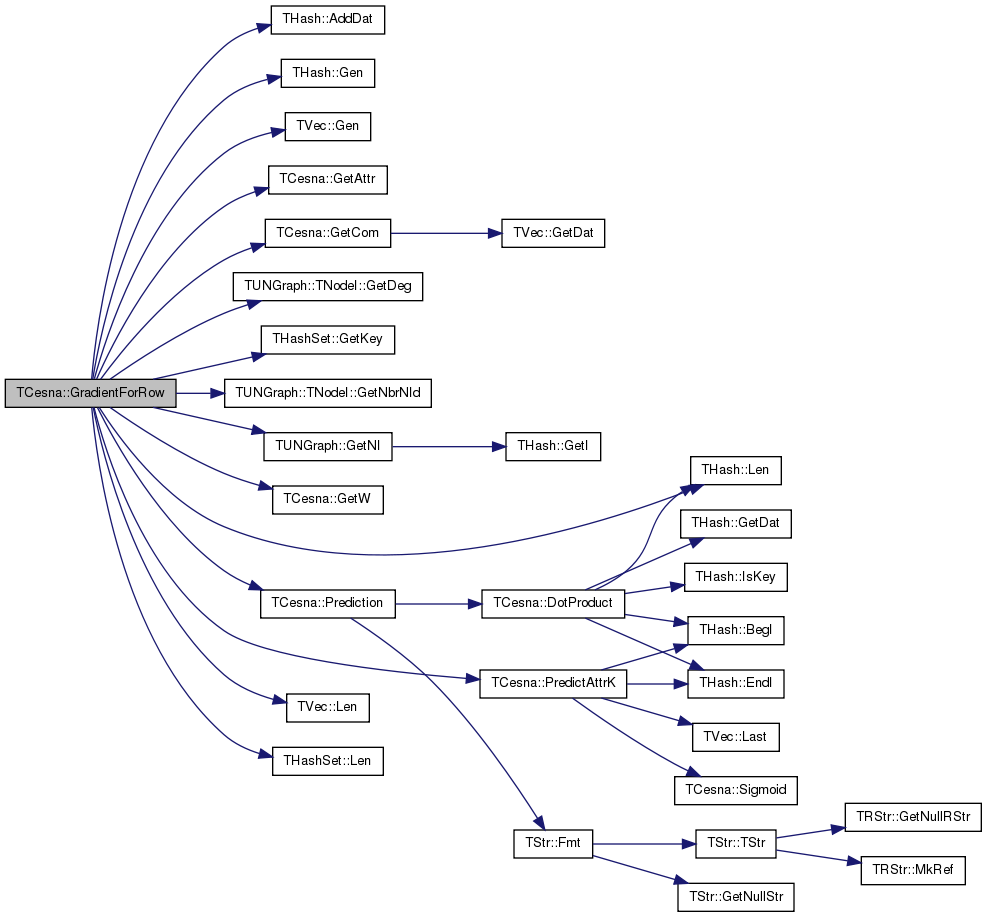

| void TCesna::GradientForWK | ( | TFltV & | GradV, |
| const int | K | ||
| ) | [inline] |
Definition at line 418 of file agmattr.h.
References TVec< TVal, TSizeTy >::EndI(), F, TVec< TVal, TSizeTy >::Gen(), GetAttr(), GetCom(), GetW(), HOKIDSV, LassoCoef, TVec< TVal, TSizeTy >::Len(), NumComs, PredictAttrK(), and TMath::Sign().
Referenced by MLEGradAscent(), and MLEGradAscentParallel().
{
GradV.Gen(NumComs + 1);
for (int u = 0; u < F.Len(); u++) {
if (HOKIDSV[u].IsKey(K)) { continue; }
double Pred = PredictAttrK(u, K);
for (TIntFltH::TIter CI = F[u].BegI(); CI < F[u].EndI(); CI++) {
GradV[CI.GetKey()] += (GetAttr(u, K) - Pred) * GetCom(u, CI.GetKey());
}
GradV[NumComs] += (GetAttr(u, K) - Pred);
}
for (int c = 0; c < GradV.Len() - 1; c++) {
GradV[c] -= LassoCoef * TMath::Sign(GetW(c, K));
}
}


| void TCesna::InitW | ( | ) | [inline] |
Definition at line 328 of file agmattr.h.
References Attrs, TVec< TVal, TSizeTy >::Gen(), NumComs, and W.
Referenced by NeighborComInit(), RandomInit(), SetCmtyVV(), and SetGraph().


| double TCesna::Likelihood | ( | const bool | DoParallel = false | ) |
Definition at line 137 of file agmattr.cpp.
References F, TVec< TVal, TSizeTy >::Len(), and LikelihoodForRow().
Referenced by FindComs(), LikelihoodGraph(), MLEGradAscent(), and MLEGradAscentParallel().
{
TExeTm ExeTm;
double L = 0.0;
if (_DoParallel) {
#pragma omp parallel for
for (int u = 0; u < F.Len(); u++) {
double LU = LikelihoodForRow(u);
#pragma omp atomic
L += LU;
}
}
else {
for (int u = 0; u < F.Len(); u++) {
double LU = LikelihoodForRow(u);
L += LU;
}
}
return L;
}


| double TCesna::LikelihoodAttr | ( | ) | [inline] |
Definition at line 368 of file agmattr.h.
References Attrs, F, HOKIDSV, TVec< TVal, TSizeTy >::Len(), LikelihoodAttrKForRow(), and W.
Referenced by FindComs(), and LikelihoodGraph().
{
double L = 0.0;
for (int k = 0; k < Attrs; k++) {
for (int u = 0; u < F.Len(); u++) {
if (HOKIDSV[u].IsKey(k)) { continue; }
L += LikelihoodAttrKForRow(u, k, F[u], W[k]);
}
}
return L;
}


| double TCesna::LikelihoodAttrKForRow | ( | const int | UID, |
| const int | K | ||
| ) | [inline] |
Definition at line 353 of file agmattr.h.
References F, and LikelihoodAttrKForRow().
Referenced by LikelihoodAttr(), LikelihoodAttrKForRow(), LikelihoodForRow(), LikelihoodForWK(), and LikelihoodHoldOut().
{ return LikelihoodAttrKForRow(UID, K, F[UID]); }


| double TCesna::LikelihoodAttrKForRow | ( | const int | UID, |
| const int | K, | ||
| const TIntFltH & | FU | ||
| ) | [inline] |
Definition at line 354 of file agmattr.h.
References LikelihoodAttrKForRow(), and W.
Referenced by LikelihoodAttrKForRow().
{ return LikelihoodAttrKForRow(UID, K, FU, W[K]); }


| double TCesna::LikelihoodAttrKForRow | ( | const int | UID, |
| const int | K, | ||
| const TIntFltH & | FU, | ||
| const TFltV & | WK | ||
| ) |
Definition at line 202 of file agmattr.cpp.
References GetAttr(), and PredictAttrK().
{
double Prob = PredictAttrK(FU, WK);
double L = 0.0;
if (GetAttr(UID, K)) {
L = Prob == 0.0? -100.0: log(Prob);
} else {
L = Prob == 1.0? -100.0: log(1.0 - Prob);
}
return L;
}
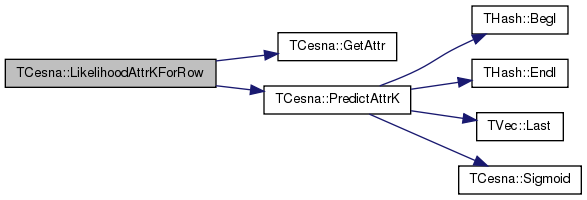
| double TCesna::LikelihoodForRow | ( | const int | UID | ) |
Definition at line 157 of file agmattr.cpp.
References F.
Referenced by GetStepSizeByLineSearch(), and Likelihood().
{
return LikelihoodForRow(UID, F[UID]);
}

| double TCesna::LikelihoodForRow | ( | const int | UID, |
| const TIntFltH & | FU | ||
| ) |
Definition at line 161 of file agmattr.cpp.
References Attrs, THash< TKey, TDat, THashFunc >::BegI(), DotProduct(), THash< TKey, TDat, THashFunc >::EndI(), F, G, TVec< TVal, TSizeTy >::Gen(), GetCom(), TUNGraph::TNodeI::GetDeg(), TUNGraph::TNodeI::GetNbrNId(), TUNGraph::GetNI(), HOKIDSV, HOVIDSV, TVec< TVal, TSizeTy >::Len(), LikelihoodAttrKForRow(), NegWgt, Norm2(), Prediction(), RegCoef, Sum(), SumFV, and WeightAttr.
{
double L = 0.0;
TFltV HOSumFV; //adjust for Fv of v hold out
if (HOVIDSV[UID].Len() > 0) {
HOSumFV.Gen(SumFV.Len());
for (int e = 0; e < HOVIDSV[UID].Len(); e++) {
for (int c = 0; c < SumFV.Len(); c++) {
HOSumFV[c] += GetCom(HOVIDSV[UID][e], c);
}
}
}
TUNGraph::TNodeI NI = G->GetNI(UID);
for (int e = 0; e < NI.GetDeg(); e++) {
int v = NI.GetNbrNId(e);
if (v == UID) { continue; }
if (HOVIDSV[UID].IsKey(v)) { continue; }
L += log (1.0 - Prediction(FU, F[v])) + NegWgt * DotProduct(FU, F[v]);
}
for (TIntFltH::TIter HI = FU.BegI(); HI < FU.EndI(); HI++) {
double HOSum = HOVIDSV[UID].Len() > 0? HOSumFV[HI.GetKey()].Val: 0.0;//subtract Hold out pairs only if hold out pairs exist
L -= NegWgt * (SumFV[HI.GetKey()] - HOSum - GetCom(UID, HI.GetKey())) * HI.GetDat();
}
//add regularization
if (RegCoef > 0.0) { //L1
L -= RegCoef * Sum(FU);
}
if (RegCoef < 0.0) { //L2
L += RegCoef * Norm2(FU);
}
L *= (1.0 - WeightAttr);
// add attribute part
for (int k = 0; k < Attrs; k++) {
if (HOKIDSV[UID].IsKey(k)) { continue; }
L += WeightAttr * LikelihoodAttrKForRow(UID, k, FU);
}
return L;
}
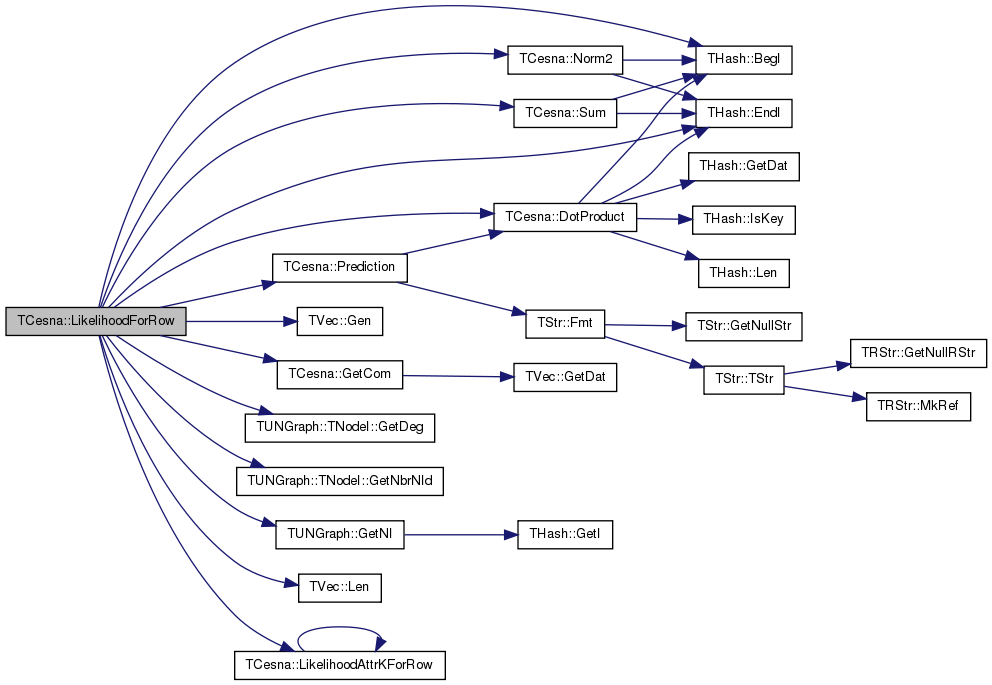
| double TCesna::LikelihoodForWK | ( | const int | K, |
| const TFltV & | WK | ||
| ) | [inline] |
Definition at line 356 of file agmattr.h.
References F, HOKIDSV, LassoCoef, TVec< TVal, TSizeTy >::Len(), and LikelihoodAttrKForRow().
Referenced by GetStepSizeByLineSearchForWK().
{
double L = 0.0;
for (int u = 0; u < F.Len(); u++) {
if (HOKIDSV[u].IsKey(K)) { continue; }
L += LikelihoodAttrKForRow(u, K, F[u], WK);
}
for (int c = 0; c < WK.Len() - 1; c++) {
L -= LassoCoef * fabs(WK[c]);
}
return L;
}


| double TCesna::LikelihoodForWK | ( | const int | K | ) | [inline] |
Definition at line 367 of file agmattr.h.
References LikelihoodForWK(), and W.
Referenced by LikelihoodForWK().
{ return LikelihoodForWK(K, W[K]); }


| double TCesna::LikelihoodGraph | ( | ) | [inline] |
Definition at line 378 of file agmattr.h.
References F, TVec< TVal, TSizeTy >::Len(), Likelihood(), LikelihoodAttr(), Norm2(), RegCoef, Sum(), and WeightAttr.
{
double L = Likelihood();
//add regularization
if (RegCoef > 0.0) { //L1
for (int u = 0; u < F.Len(); u++) {
L += RegCoef * Sum(F[u]);
}
}
if (RegCoef < 0.0) { //L2
for (int u = 0; u < F.Len(); u++) {
L -= RegCoef * Norm2(F[u]);
}
}
return L - WeightAttr * LikelihoodAttr();
}

| double TCesna::LikelihoodHoldOut | ( | ) |
Definition at line 452 of file agmattr.cpp.
References Attrs, G, HOKIDSV, HOVIDSV, IAssert, TUNGraph::IsEdge(), TVec< TVal, TSizeTy >::Len(), LikelihoodAttrKForRow(), NegWgt, Prediction(), and WeightAttr.
Referenced by FindComs().
{
double L = 0.0;
for (int u = 0; u < HOVIDSV.Len(); u++) {
for (int e = 0; e < HOVIDSV[u].Len(); e++) {
int VID = HOVIDSV[u][e];
if (VID == u) { continue; }
double Pred = Prediction(u, VID);
if (G->IsEdge(u, VID)) {
L += log(1.0 - Pred);
}
else {
L += NegWgt * log(Pred);
}
//printf("NODE %d, %d: Dot Prod: %f, Prediction: %f L:%f\n", u, VID, DotProduct(F[u], F[VID]), Pred, L);
}
}
L *= (1.0 - WeightAttr);
//printf("likelihood for hold out network:%f\n", L);
for (int u = 0; u < HOKIDSV.Len(); u++) {
for (int e = 0; e < HOKIDSV[u].Len(); e++) {
IAssert(HOKIDSV[u][e] < Attrs);
L += WeightAttr * LikelihoodAttrKForRow(u, HOKIDSV[u][e]);
//printf("asbefsafd ATTRIBUTE %d, NODE %d:%f\n", u, HOKIDSV[u][e].Val, LikelihoodAttrKForRow(u, HOKIDSV[u][e]));
}
}
return L;
}
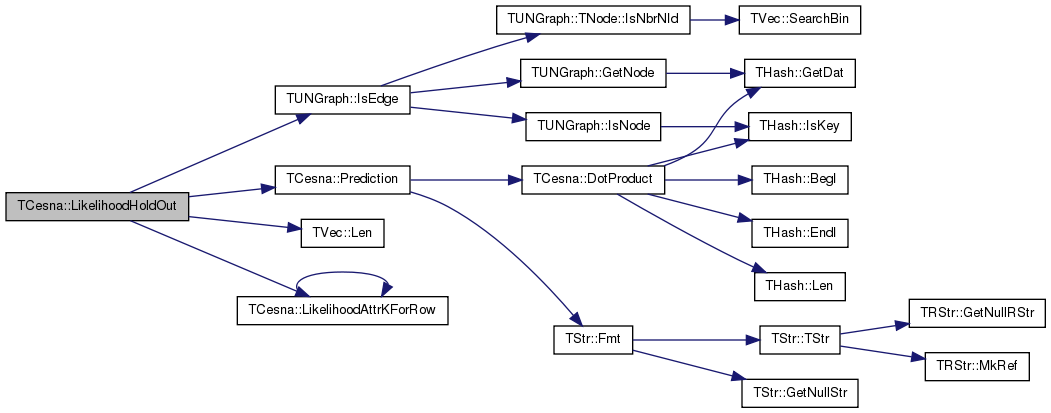

| void TCesna::Load | ( | TSIn & | SIn, |
| const int & | RndSeed = 0 |
||
| ) | [inline] |
Definition at line 291 of file agmattr.h.
References Attrs, F, G, HOKIDSV, HOVIDSV, LassoCoef, TUNGraph::Load(), TVec< TVal, TSizeTy >::Load(), TInt::Load(), THashSet< TKey, THashFunc >::Load(), TFlt::Load(), MaxVal, MaxValW, MinVal, MinValW, NegWgt, NIDToIdx, NumComs, PNoCom, RegCoef, SumFV, W, and X.
{
G->Load(SIn);
X.Load(SIn);
F.Load(SIn);
W.Load(SIn);
Attrs.Load(SIn);
NIDToIdx.Load(SIn);
RegCoef.Load(SIn);
LassoCoef.Load(SIn);
SumFV.Load(SIn);
NumComs.Load(SIn);
HOVIDSV.Load(SIn);
HOKIDSV.Load(SIn);
MinVal.Load(SIn);
MaxVal.Load(SIn);
MinValW.Load(SIn);
MaxValW.Load(SIn);
NegWgt.Load(SIn);
PNoCom.Load(SIn);
}
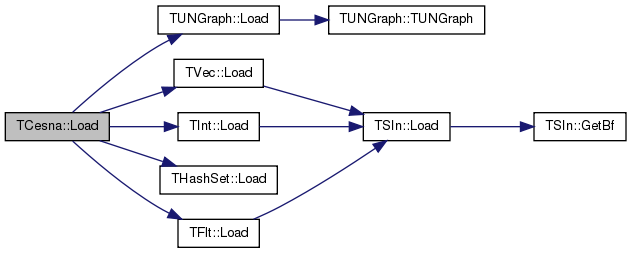
| int TCesna::MLEGradAscent | ( | const double & | Thres, |
| const int & | MaxIter, | ||
| const TStr | PlotNm, | ||
| const double | StepAlpha = 0.3, |
||
| const double | StepBeta = 0.1 |
||
| ) |
Definition at line 505 of file agmattr.cpp.
References TVec< TVal, TSizeTy >::Add(), AddCom(), THashSet< TKey, THashFunc >::AddKey(), Attrs, DelCom(), TStr::Empty(), F, G, GetCom(), THash< TKey, TDat, THashFunc >::GetDat(), THash< TKey, TDat, THashFunc >::GetKey(), TUNGraph::GetNodes(), GetStepSizeByLineSearch(), GetStepSizeByLineSearchForWK(), TExeTm::GetTmStr(), GradientForRow(), GradientForWK(), THash< TKey, TDat, THashFunc >::Len(), TVec< TVal, TSizeTy >::Len(), Likelihood(), MaxValW, MinValW, TFlt::Mn, TLinAlg::Norm2(), Norm2(), NumComs, TGnuPlot::PlotValV(), Rnd, and W.
Referenced by FindComs().
{
time_t InitTime = time(NULL);
TExeTm ExeTm, CheckTm;
int iter = 0, PrevIter = 0;
TIntFltPrV IterLV;
TUNGraph::TNodeI UI;
double PrevL = TFlt::Mn, CurL = 0.0;
TIntV NIdxV(F.Len(), 0);
for (int i = 0; i < F.Len(); i++) { NIdxV.Add(i); }
TIntFltH GradV;
//consider all C
TIntSet CIDSet(NumComs);
for (int c = 0; c < NumComs; c++) { CIDSet.AddKey(c); }
while(iter < MaxIter) {
NIdxV.Shuffle(Rnd);
for (int ui = 0; ui < F.Len(); ui++, iter++) {
int u = NIdxV[ui]; //
/*
//find set of candidate c (we only need to consider c to which a neighbor of u belongs to)
UI = G->GetNI(u);
TIntSet CIDSet(20 * UI.GetDeg());
for (int e = 0; e < UI.GetDeg(); e++) {
if (HOVIDSV[u].IsKey(UI.GetNbrNId(e))) { continue; }
TIntFltH& NbhCIDH = F[UI.GetNbrNId(e)];
for (TIntFltH::TIter CI = NbhCIDH.BegI(); CI < NbhCIDH.EndI(); CI++) {
CIDSet.AddKey(CI.GetKey());
}
}
for (TIntFltH::TIter CI = F[u].BegI(); CI < F[u].EndI(); CI++) { //remove the community membership which U does not share with its neighbors
if (! CIDSet.IsKey(CI.GetKey())) {
DelCom(u, CI.GetKey());
}
}
if (CIDSet.Empty()) { continue; }
*/
GradientForRow(u, GradV, CIDSet);
if (Norm2(GradV) < 1e-4) { continue; }
double LearnRate = GetStepSizeByLineSearch(u, GradV, GradV, StepAlpha, StepBeta);
if (LearnRate == 0.0) { continue; }
for (int ci = 0; ci < GradV.Len(); ci++) {
int CID = GradV.GetKey(ci);
double Change = LearnRate * GradV.GetDat(CID);
double NewFuc = GetCom(u, CID) + Change;
if (NewFuc <= 0.0) {
DelCom(u, CID);
} else {
AddCom(u, CID, NewFuc);
}
}
if (! PlotNm.Empty() && (iter + 1) % G->GetNodes() == 0) {
IterLV.Add(TIntFltPr(iter, Likelihood(false)));
}
}
// fit W (logistic regression)
for (int k = 0; k < Attrs; k++) {
TFltV GradWV(NumComs);
GradientForWK(GradWV, k);
if (TLinAlg::Norm2(GradWV) < 1e-4) { continue; }
double LearnRate = GetStepSizeByLineSearchForWK(k, GradWV, GradWV, StepAlpha, StepBeta);
if (LearnRate == 0.0) { continue; }
for (int c = 0; c < GradWV.Len(); c++){
W[k][c] += LearnRate * GradWV[c];
if (W[k][c] < MinValW) { W[k][c] = MinValW; }
if (W[k][c] > MaxValW) { W[k][c] = MaxValW; }
}
}
printf("\r%d iterations (%f) [%lu sec]", iter, CurL, time(NULL) - InitTime);
fflush(stdout);
if (iter - PrevIter >= 2 * G->GetNodes() && iter > 10000) {
PrevIter = iter;
CurL = Likelihood();
if (PrevL > TFlt::Mn && ! PlotNm.Empty()) {
printf("\r%d iterations, Likelihood: %f, Diff: %f", iter, CurL, CurL - PrevL);
}
fflush(stdout);
if (CurL - PrevL <= Thres * fabs(PrevL)) { break; }
else { PrevL = CurL; }
}
}
printf("\n");
printf("MLE for Lambda completed with %d iterations(%s)\n", iter, ExeTm.GetTmStr());
if (! PlotNm.Empty()) {
TGnuPlot::PlotValV(IterLV, PlotNm + ".likelihood_Q");
}
return iter;
}
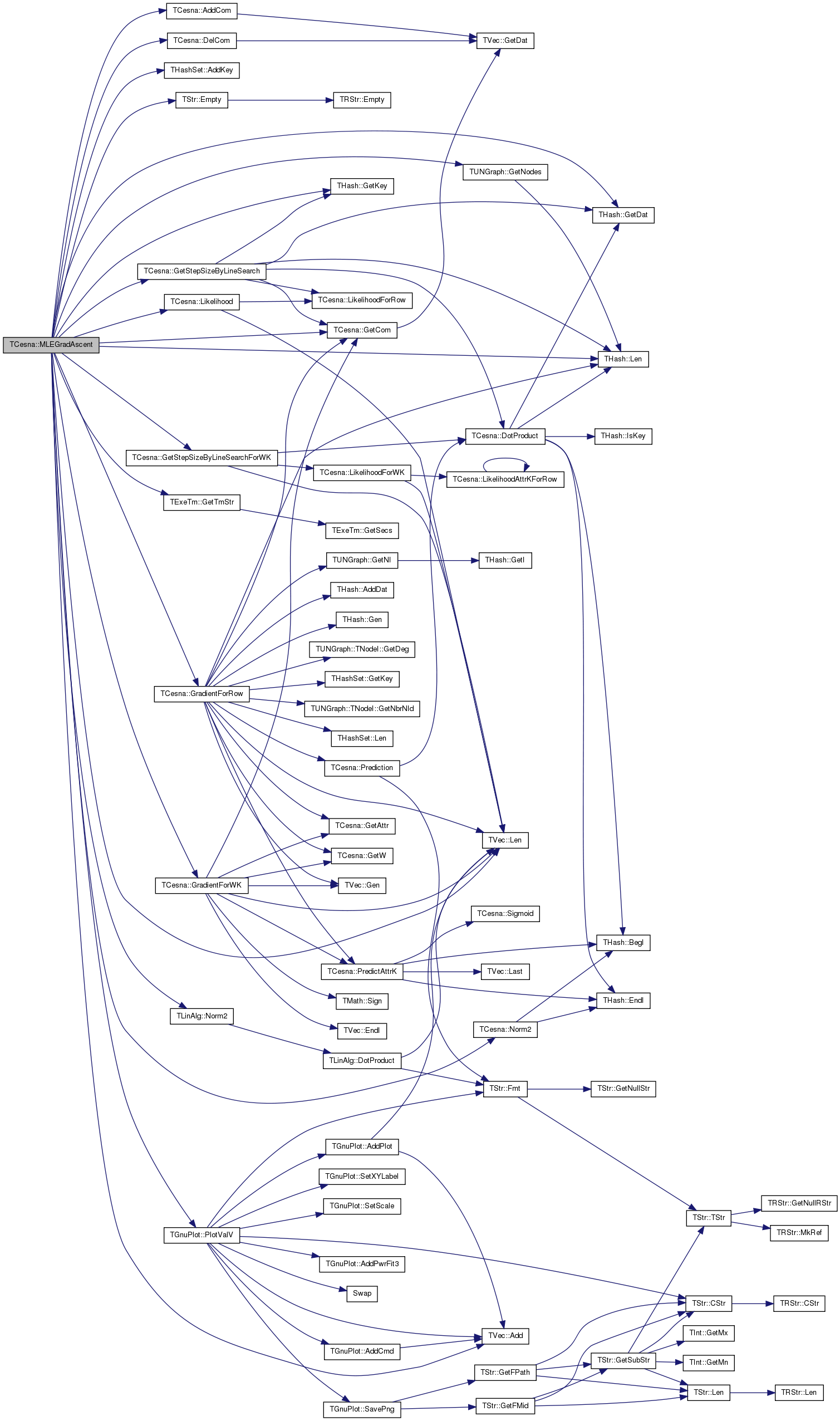

| int TCesna::MLEGradAscentParallel | ( | const double & | Thres, |
| const int & | MaxIter, | ||
| const int | ChunkNum, | ||
| const int | ChunkSize, | ||
| const TStr | PlotNm, | ||
| const double | StepAlpha = 0.3, |
||
| const double | StepBeta = 0.1 |
||
| ) |
Definition at line 594 of file agmattr.cpp.
References TVec< TVal, TSizeTy >::Add(), Attrs, THash< TKey, TDat, THashFunc >::BegI(), TVec< TVal, TSizeTy >::Clr(), TStr::CStr(), TStr::Empty(), THashKeyDatI< TKey, TDat >::EndI, THash< TKey, TDat, THashFunc >::EndI(), TVec< TVal, TSizeTy >::EndI(), F, G, TSecTm::GetAbsSecs(), TSecTm::GetCurTm(), THash< TKey, TDat, THashFunc >::GetDat(), TVec< TVal, TSizeTy >::GetDat(), TUNGraph::TNodeI::GetDeg(), THash< TKey, TDat, THashFunc >::GetKey(), TUNGraph::TNodeI::GetNbrNId(), TUNGraph::GetNI(), TUNGraph::GetNodes(), GetStepSizeByLineSearch(), GetStepSizeByLineSearchForWK(), TUInt64::GetStr(), TExeTm::GetTmStr(), GradientForRow(), GradientForWK(), HOVIDSV, IAssert, THash< TKey, TDat, THashFunc >::Len(), TVec< TVal, TSizeTy >::Len(), Likelihood(), MaxValW, MinValW, TFlt::Mn, TLinAlg::Norm2(), Norm2(), NumComs, TGnuPlot::PlotValV(), TVec< TVal, TSizeTy >::PutAll(), Rnd, SumFV, and W.
Referenced by FindComs(), and MLEGradAscentParallel().
{
//parallel
time_t InitTime = time(NULL);
uint64 StartTm = TSecTm::GetCurTm().GetAbsSecs();
TExeTm ExeTm, CheckTm;
double PrevL = Likelihood(true);
TIntFltPrV IterLV;
int PrevIter = 0;
int iter = 0;
TIntV NIdxV(F.Len(), 0);
for (int i = 0; i < F.Len(); i++) { NIdxV.Add(i); }
TIntV NIDOPTV(F.Len()); //check if a node needs optimization or not 1: does not require optimization
NIDOPTV.PutAll(0);
TVec<TIntFltH> NewF(ChunkNum * ChunkSize);
TIntV NewNIDV(ChunkNum * ChunkSize);
for (iter = 0; iter < MaxIter; iter++) {
NIdxV.Clr(false);
for (int i = 0; i < F.Len(); i++) {
if (NIDOPTV[i] == 0) { NIdxV.Add(i); }
}
IAssert (NIdxV.Len() <= F.Len());
NIdxV.Shuffle(Rnd);
// compute gradient for chunk of nodes
#pragma omp parallel for schedule(static, 1)
for (int TIdx = 0; TIdx < ChunkNum; TIdx++) {
TIntFltH GradV;
for (int ui = TIdx * ChunkSize; ui < (TIdx + 1) * ChunkSize; ui++) {
NewNIDV[ui] = -1;
if (ui >= NIdxV.Len()) { continue; }
int u = NIdxV[ui]; //
//find set of candidate c (we only need to consider c to which a neighbor of u belongs to)
TUNGraph::TNodeI UI = G->GetNI(u);
TIntSet CIDSet(5 * UI.GetDeg());
TIntFltH CurFU = F[u];
for (int e = 0; e < UI.GetDeg(); e++) {
if (HOVIDSV[u].IsKey(UI.GetNbrNId(e))) { continue; }
TIntFltH& NbhCIDH = F[UI.GetNbrNId(e)];
for (TIntFltH::TIter CI = NbhCIDH.BegI(); CI < NbhCIDH.EndI(); CI++) {
CIDSet.AddKey(CI.GetKey());
}
}
if (CIDSet.Empty()) {
CurFU.Clr();
}
else {
for (TIntFltH::TIter CI = CurFU.BegI(); CI < CurFU.EndI(); CI++) { //remove the community membership which U does not share with its neighbors
if (! CIDSet.IsKey(CI.GetKey())) {
CurFU.DelIfKey(CI.GetKey());
}
}
GradientForRow(u, GradV, CIDSet);
if (Norm2(GradV) < 1e-4) { NIDOPTV[u] = 1; continue; }
double LearnRate = GetStepSizeByLineSearch(u, GradV, GradV, StepAlpha, StepBeta);
if (LearnRate == 0.0) { NewNIDV[ui] = -2; continue; }
for (int ci = 0; ci < GradV.Len(); ci++) {
int CID = GradV.GetKey(ci);
double Change = LearnRate * GradV.GetDat(CID);
double NewFuc = CurFU.IsKey(CID)? CurFU.GetDat(CID) + Change : Change;
if (NewFuc <= 0.0) {
CurFU.DelIfKey(CID);
} else {
CurFU.AddDat(CID) = NewFuc;
}
}
CurFU.Defrag();
}
//store changes
NewF[ui] = CurFU;
NewNIDV[ui] = u;
}
}
int NumNoChangeGrad = 0;
int NumNoChangeStepSize = 0;
for (int ui = 0; ui < NewNIDV.Len(); ui++) {
int NewNID = NewNIDV[ui];
if (NewNID == -1) { NumNoChangeGrad++; continue; }
if (NewNID == -2) { NumNoChangeStepSize++; continue; }
for (TIntFltH::TIter CI = F[NewNID].BegI(); CI < F[NewNID].EndI(); CI++) {
SumFV[CI.GetKey()] -= CI.GetDat();
}
}
#pragma omp parallel for
for (int ui = 0; ui < NewNIDV.Len(); ui++) {
int NewNID = NewNIDV[ui];
if (NewNID < 0) { continue; }
F[NewNID] = NewF[ui];
}
for (int ui = 0; ui < NewNIDV.Len(); ui++) {
int NewNID = NewNIDV[ui];
if (NewNID < 0) { continue; }
for (TIntFltH::TIter CI = F[NewNID].BegI(); CI < F[NewNID].EndI(); CI++) {
SumFV[CI.GetKey()] += CI.GetDat();
}
}
// update the nodes who are optimal
for (int ui = 0; ui < NewNIDV.Len(); ui++) {
int NewNID = NewNIDV[ui];
if (NewNID < 0) { continue; }
TUNGraph::TNodeI UI = G->GetNI(NewNID);
NIDOPTV[NewNID] = 0;
for (int e = 0; e < UI.GetDeg(); e++) {
NIDOPTV[UI.GetNbrNId(e)] = 0;
}
}
int OPTCnt = 0;
for (int i = 0; i < NIDOPTV.Len(); i++) { if (NIDOPTV[i] == 1) { OPTCnt++; } }
// fit W (logistic regression)
if (! PlotNm.Empty()) {
printf("\r%d iterations [%s] %s secs", iter * ChunkSize * ChunkNum, ExeTm.GetTmStr(), TUInt64::GetStr(TSecTm::GetCurTm().GetAbsSecs()-StartTm).CStr());
if (PrevL > TFlt::Mn) { printf(" (%f) %d g %d s %d OPT", PrevL, NumNoChangeGrad, NumNoChangeStepSize, OPTCnt); }
fflush(stdout);
}
if (iter == 0 || (iter - PrevIter) * ChunkSize * ChunkNum >= G->GetNodes()) {
#pragma omp parallel for
for (int k = 0; k < Attrs; k++) {
TFltV GradWV(NumComs);
GradientForWK(GradWV, k);
if (TLinAlg::Norm2(GradWV) < 1e-4) { continue; }
double LearnRate = GetStepSizeByLineSearchForWK(k, GradWV, GradWV, StepAlpha, StepBeta);
if (LearnRate == 0.0) { continue; }
for (int c = 0; c < GradWV.Len(); c++){
W[k][c] += LearnRate * GradWV[c];
if (W[k][c] < MinValW) { W[k][c] = MinValW; }
if (W[k][c] > MaxValW) { W[k][c] = MaxValW; }
}
}
PrevIter = iter;
double CurL = Likelihood(true);
IterLV.Add(TIntFltPr(iter * ChunkSize * ChunkNum, CurL));
printf("\r%d iterations, Likelihood: %f, Diff: %f [%lu secs]", iter, CurL, CurL - PrevL, time(NULL) - InitTime);
fflush(stdout);
if (CurL - PrevL <= Thres * fabs(PrevL)) {
break;
}
else {
PrevL = CurL;
}
}
}
if (! PlotNm.Empty()) {
printf("\nMLE completed with %d iterations(%s secs)\n", iter, TUInt64::GetStr(TSecTm::GetCurTm().GetAbsSecs()-StartTm).CStr());
TGnuPlot::PlotValV(IterLV, PlotNm + ".likelihood_Q");
} else {
printf("\rMLE completed with %d iterations(%lu secs)", iter, time(NULL) - InitTime);
fflush(stdout);
}
return iter;
}
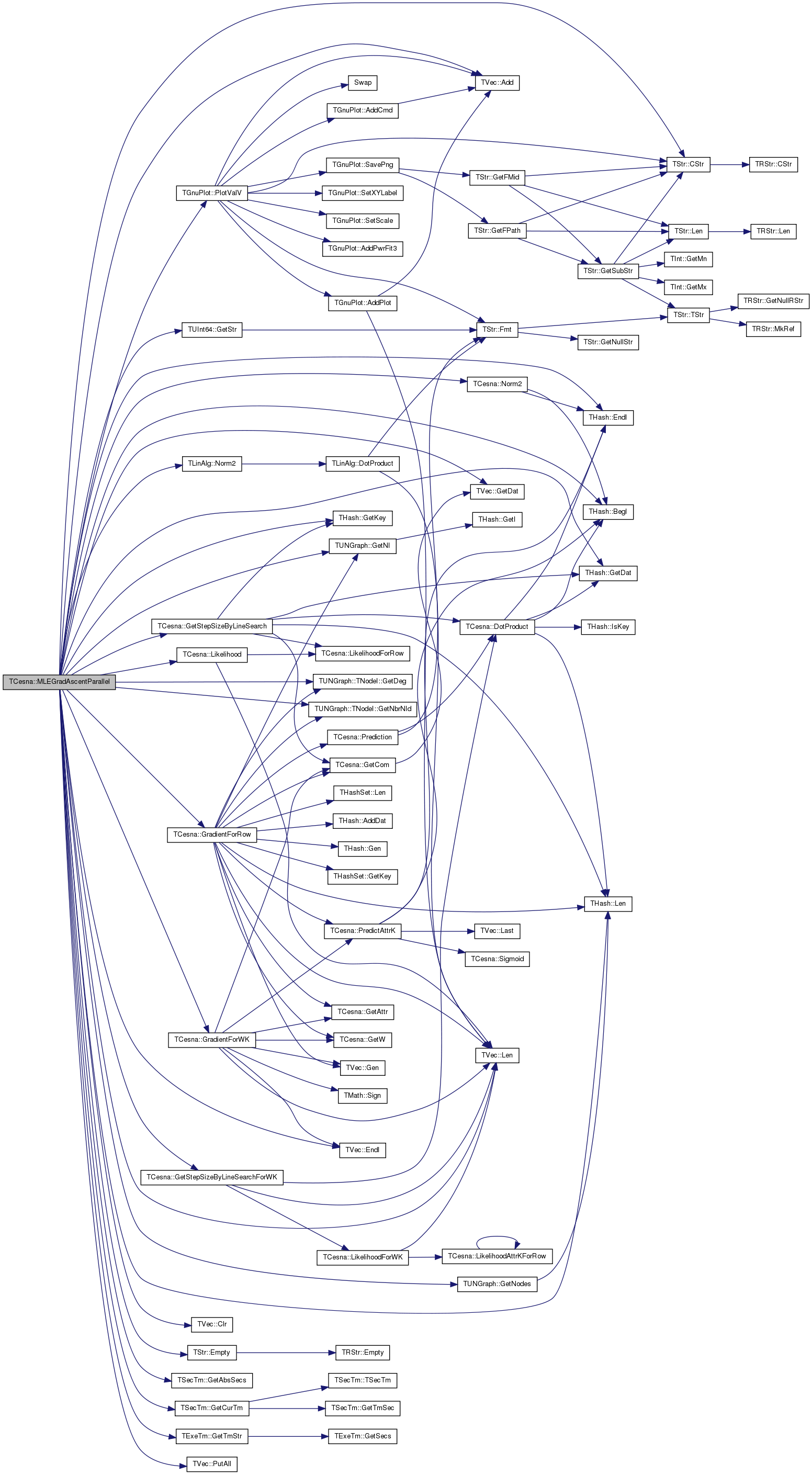

| int TCesna::MLEGradAscentParallel | ( | const double & | Thres, |
| const int & | MaxIter, | ||
| const int | ChunkNum, | ||
| const TStr | PlotNm = TStr(), |
||
| const double | StepAlpha = 0.3, |
||
| const double | StepBeta = 0.1 |
||
| ) | [inline] |
Definition at line 518 of file agmattr.h.
References G, TUNGraph::GetNodes(), and MLEGradAscentParallel().
{
int ChunkSize = G->GetNodes() / 10 / ChunkNum;
if (ChunkSize == 0) { ChunkSize = 1; }
return MLEGradAscentParallel(Thres, MaxIter, ChunkNum, ChunkSize, PlotNm, StepAlpha, StepBeta);
}
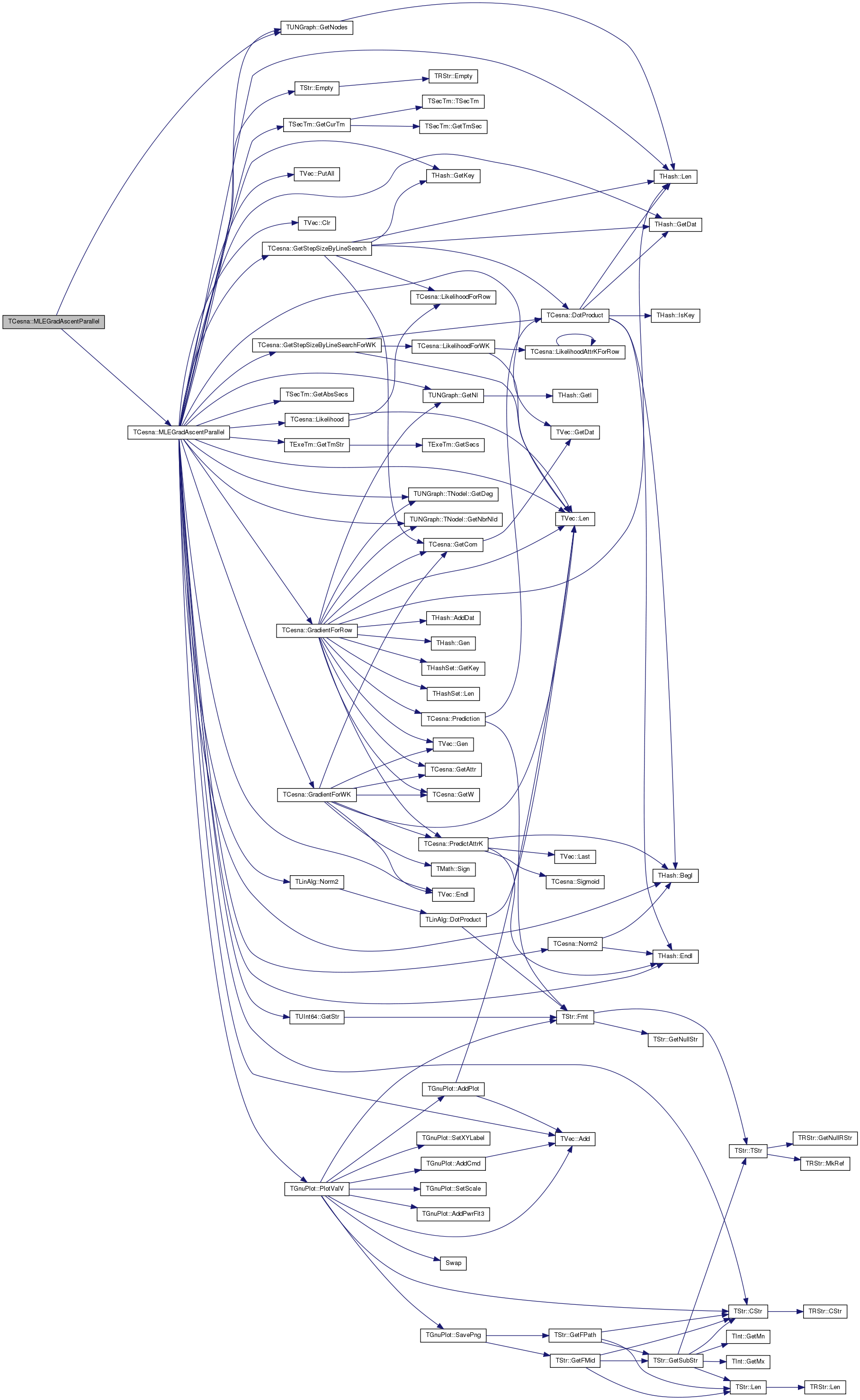
| void TCesna::NeighborComInit | ( | const int | InitComs | ) |
Definition at line 32 of file agmattr.cpp.
References F, G, and TVec< TVal, TSizeTy >::Len().
Referenced by FindComs(), and TCesna().
{
//initialize with best neighborhood communities (Gleich et.al. KDD'12)
TFltIntPrV NIdPhiV(F.Len(), 0);
TCesnaUtil::GetNIdPhiV<PUNGraph>(G, NIdPhiV);
NeighborComInit(NIdPhiV, InitComs);
}


| void TCesna::NeighborComInit | ( | TFltIntPrV & | NIdPhiV, |
| const int | InitComs | ||
| ) |
Definition at line 39 of file agmattr.cpp.
References AddCom(), F, G, TVec< TVal, TSizeTy >::Gen(), TUNGraph::TNodeI::GetDeg(), TUNGraph::TNodeI::GetNbrNId(), TUNGraph::GetNI(), TUNGraph::GetNodes(), TRnd::GetUniDev(), TRnd::GetUniDevInt(), InitW(), TVec< TVal, TSizeTy >::Len(), NumComs, Rnd, TVec< TVal, TSizeTy >::Sort(), and SumFV.
{
//initialize with best neighborhood communities (Gleich et.al. KDD'12)
NIdPhiV.Sort(true);
F.Gen(G->GetNodes());
SumFV.Gen(InitComs);
NumComs = InitComs;
TIntSet InvalidNIDS(F.Len());
TIntV ChosenNIDV(InitComs, 0); //FOR DEBUG
//choose nodes with local minimum in conductance
int CurCID = 0;
for (int ui = 0; ui < NIdPhiV.Len(); ui++) {
int UID = NIdPhiV[ui].Val2;
fflush(stdout);
if (InvalidNIDS.IsKey(UID)) { continue; }
ChosenNIDV.Add(UID); //FOR DEBUG
//add the node and its neighbors to the current community
AddCom(UID, CurCID, 1.0);
TUNGraph::TNodeI NI = G->GetNI(UID);
fflush(stdout);
for (int e = 0; e < NI.GetDeg(); e++) {
AddCom(NI.GetNbrNId(e), CurCID, 1.0);
}
//exclude its neighbors from the next considerations
for (int e = 0; e < NI.GetDeg(); e++) {
InvalidNIDS.AddKey(NI.GetNbrNId(e));
}
CurCID++;
fflush(stdout);
if (CurCID >= NumComs) { break; }
}
if (NumComs > CurCID) {
printf("%d communities needed to fill randomly\n", NumComs - CurCID);
}
//assign a member to zero-member community (if any)
for (int c = 0; c < SumFV.Len(); c++) {
if (SumFV[c] == 0.0) {
int ComSz = 10;
for (int u = 0; u < ComSz; u++) {
int UID = Rnd.GetUniDevInt(G->GetNodes());
AddCom(UID, c, Rnd.GetUniDev());
}
}
}
InitW();
}
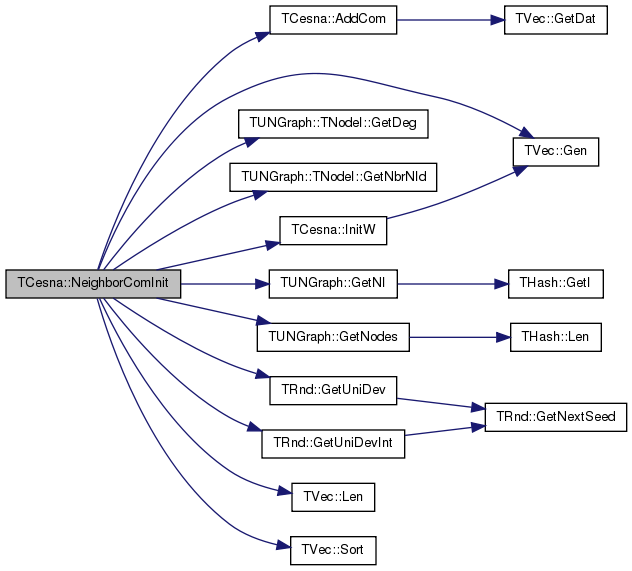
| double TCesna::Norm2 | ( | const TIntFltH & | UV | ) | [inline] |
Definition at line 613 of file agmattr.h.
References THash< TKey, TDat, THashFunc >::BegI(), and THash< TKey, TDat, THashFunc >::EndI().
Referenced by LikelihoodForRow(), LikelihoodGraph(), MLEGradAscent(), and MLEGradAscentParallel().
{
double N = 0.0;
for (TIntFltH::TIter HI = UV.BegI(); HI < UV.EndI(); HI++) {
N += HI.GetDat() * HI.GetDat();
}
return N;
}


| double TCesna::PredictAttrK | ( | const TIntFltH & | FU, |
| const TFltV & | WK | ||
| ) | [inline] |
Definition at line 586 of file agmattr.h.
References THash< TKey, TDat, THashFunc >::BegI(), THash< TKey, TDat, THashFunc >::EndI(), TVec< TVal, TSizeTy >::Last(), and Sigmoid().
Referenced by GradientForRow(), GradientForWK(), LikelihoodAttrKForRow(), and PredictAttrK().
{
double DP = 0.0;
for (TIntFltH::TIter FI = FU.BegI(); FI < FU.EndI(); FI++) {
DP += FI.GetDat() * WK[FI.GetKey()];
}
DP += WK.Last();
return Sigmoid(DP);
}
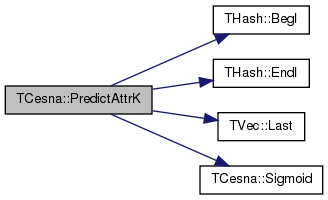

| double TCesna::PredictAttrK | ( | const TIntFltH & | FU, |
| const int | K | ||
| ) | [inline] |
Definition at line 594 of file agmattr.h.
References PredictAttrK(), and W.
{
return PredictAttrK(FU, W[K]);
}
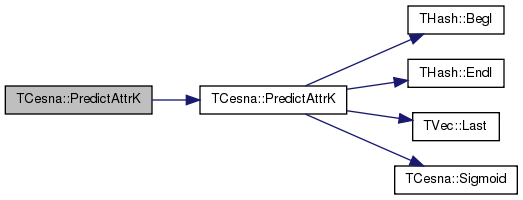
| double TCesna::PredictAttrK | ( | const int | UID, |
| const int | K | ||
| ) | [inline] |
Definition at line 597 of file agmattr.h.
References F, PredictAttrK(), and W.
{
return PredictAttrK(F[UID], W[K]);
}
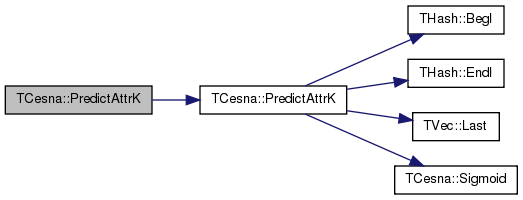
| double TCesna::Prediction | ( | const TIntFltH & | FU, |
| const TIntFltH & | FV | ||
| ) | [inline] |
Definition at line 581 of file agmattr.h.
References DotProduct(), TStr::Fmt(), IAssertR, and PNoCom.
Referenced by GradientForRow(), LikelihoodForRow(), LikelihoodHoldOut(), and Prediction().
{
double DP = log (1.0 / (1.0 - PNoCom)) + DotProduct(FU, FV);
IAssertR(DP > 0.0, TStr::Fmt("DP: %f", DP));
return exp(- DP);
}


| double TCesna::Prediction | ( | const int & | UID, |
| const int & | VID | ||
| ) | [inline] |
Definition at line 603 of file agmattr.h.
References F, and Prediction().
{
return Prediction(F[UID], F[VID]);
}
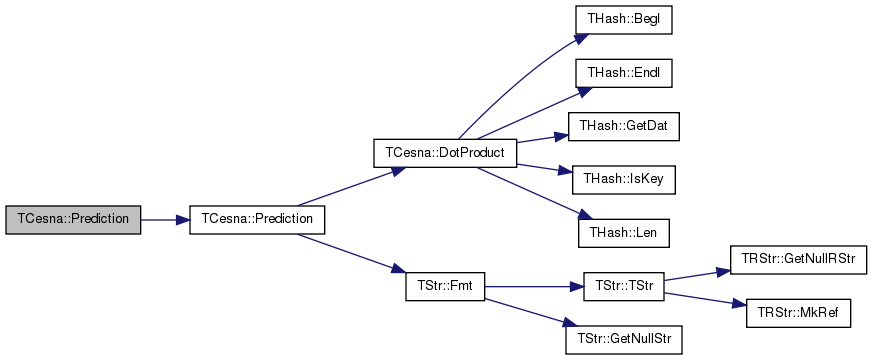
| void TCesna::RandomInit | ( | const int | InitComs | ) |
Definition at line 9 of file agmattr.cpp.
References AddCom(), F, G, TVec< TVal, TSizeTy >::Gen(), TUNGraph::TNodeI::GetDeg(), TUNGraph::GetNI(), TUNGraph::GetNodes(), TRnd::GetUniDev(), TRnd::GetUniDevInt(), InitW(), TVec< TVal, TSizeTy >::Len(), NumComs, Rnd, and SumFV.
Referenced by FindComs().
{
F.Gen(G->GetNodes());
SumFV.Gen(InitComs);
NumComs = InitComs;
for (int u = 0; u < F.Len(); u++) {
//assign to just one community
int Mem = G->GetNI(u).GetDeg();
if (Mem > 10) { Mem = 10; }
for (int c = 0; c < Mem; c++) {
int CID = Rnd.GetUniDevInt(InitComs);
AddCom(u, CID, Rnd.GetUniDev());
}
}
//assign a member to zero-member community (if any)
for (int c = 0; c < SumFV.Len(); c++) {
if (SumFV[c] == 0.0) {
int UID = Rnd.GetUniDevInt(G->GetNodes());
AddCom(UID, c, Rnd.GetUniDev());
}
}
InitW();
}
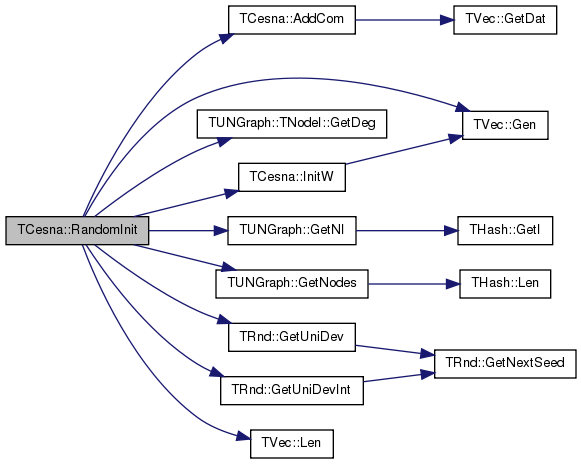

| void TCesna::Save | ( | TSOut & | SOut | ) | [inline] |
Definition at line 271 of file agmattr.h.
References Attrs, F, G, HOKIDSV, HOVIDSV, LassoCoef, MaxVal, MaxValW, MinVal, MinValW, NegWgt, NIDToIdx, NumComs, PNoCom, RegCoef, TUNGraph::Save(), TVec< TVal, TSizeTy >::Save(), TInt::Save(), THashSet< TKey, THashFunc >::Save(), TFlt::Save(), SumFV, W, and X.
{
G->Save(SOut);
X.Save(SOut);
F.Save(SOut);
W.Save(SOut);
Attrs.Save(SOut);
NIDToIdx.Save(SOut);
RegCoef.Save(SOut);
LassoCoef.Save(SOut);
SumFV.Save(SOut);
NumComs.Save(SOut);
HOVIDSV.Save(SOut);
HOKIDSV.Save(SOut);
MinVal.Save(SOut);
MaxVal.Save(SOut);
MinValW.Save(SOut);
MaxValW.Save(SOut);
NegWgt.Save(SOut);
PNoCom.Save(SOut);
}
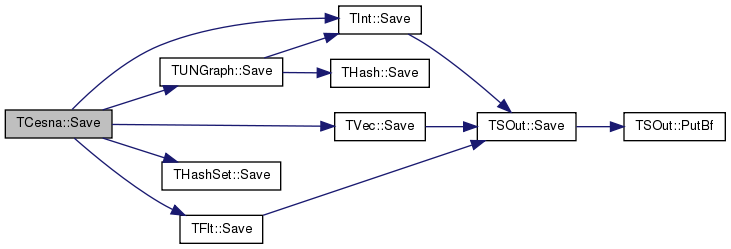
| void TCesna::SetAttrHoldOut | ( | const int | NID, |
| const int | KID | ||
| ) | [inline] |
Definition at line 334 of file agmattr.h.
References THashSet< TKey, THashFunc >::GetKeyId(), HOKIDSV, and NIDToIdx.
Referenced by SetAttrHoldOutForOneNode().


| void TCesna::SetAttrHoldOutForOneNode | ( | const int | NID | ) | [inline] |
Definition at line 338 of file agmattr.h.
References Attrs, and SetAttrHoldOut().
{
for (int k = 0; k < Attrs; k++) {
SetAttrHoldOut(NID, k);
}
}

| void TCesna::SetCmtyVV | ( | const TVec< TIntV > & | CmtyVV | ) |
Definition at line 85 of file agmattr.cpp.
References AddCom(), F, G, TVec< TVal, TSizeTy >::Gen(), THashSet< TKey, THashFunc >::GetKeyId(), TUNGraph::GetNodes(), InitW(), THashSet< TKey, THashFunc >::IsKey(), TVec< TVal, TSizeTy >::Len(), NIDToIdx, NumComs, and SumFV.
{
F.Gen(G->GetNodes());
SumFV.Gen(CmtyVV.Len());
NumComs = CmtyVV.Len();
InitW();
for (int c = 0; c < CmtyVV.Len(); c++) {
for (int u = 0; u < CmtyVV[c].Len(); u++) {
int UID = CmtyVV[c][u];
if (! NIDToIdx.IsKey(UID)) { continue; }
AddCom(NIDToIdx.GetKeyId(UID), c, 1.0);
}
}
}
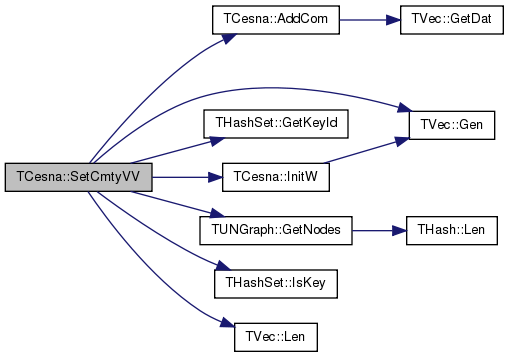
| void TCesna::SetGraph | ( | const PUNGraph & | GraphPt, |
| const THash< TInt, TIntV > & | NIDAttrH | ||
| ) |
Definition at line 99 of file agmattr.cpp.
References THashSet< TKey, THashFunc >::AddKeyV(), Attrs, TSnap::DelSelfEdges(), DoParallel, G, TVec< TVal, TSizeTy >::Gen(), THashSet< TKey, THashFunc >::Gen(), THash< TKey, TDat, THashFunc >::GetKey(), THashSet< TKey, THashFunc >::GetKeyId(), TUNGraph::GetNIdV(), TUNGraph::GetNodes(), TSnap::GetSubGraph(), HOKIDSV, HOVIDSV, IAssert, InitW(), THashSet< TKey, THashFunc >::IsKey(), TUNGraph::IsNode(), THash< TKey, TDat, THashFunc >::Len(), TVec< TVal, TSizeTy >::Len(), TFlt::Mx, NegWgt, NIDToIdx, PNoCom, and X.
Referenced by TCesna().
{
HOVIDSV.Gen(GraphPt->GetNodes());
HOKIDSV.Gen(GraphPt->GetNodes());
X.Gen(GraphPt->GetNodes());
TIntV NIDV;
GraphPt->GetNIdV(NIDV);
NIDToIdx.Gen(NIDV.Len());
NIDToIdx.AddKeyV(NIDV);
// check that nodes IDs are {0,1,..,Nodes-1}
printf("rearrage nodes\n");
G = TSnap::GetSubGraph(GraphPt, NIDV, true);
for (int nid = 0; nid < G->GetNodes(); nid++) {
IAssert(G->IsNode(nid));
}
TSnap::DelSelfEdges(G);
PNoCom = 1.0 / (double) G->GetNodes();
DoParallel = false;
if (1.0 / PNoCom > sqrt(TFlt::Mx)) { PNoCom = 0.99 / sqrt(TFlt::Mx); } // to prevent overflow
NegWgt = 1.0;
// add node attributes, find number of attributes
int NumAttr = 0;
for (int u = 0; u < NIDAttrH.Len(); u++) {
int UID = NIDAttrH.GetKey(u);
if (! NIDToIdx.IsKey(UID)) { continue; }
X[NIDToIdx.GetKeyId(UID)].Gen(NIDAttrH[u].Len());
for (int k = 0; k < NIDAttrH[u].Len(); k++) {
int KID = NIDAttrH[u][k];
IAssert (KID >= 0);
X[NIDToIdx.GetKeyId(UID)].AddKey(KID);
if (NumAttr < KID + 1) { NumAttr = KID + 1; }
}
}
Attrs = NumAttr;
InitW();
}
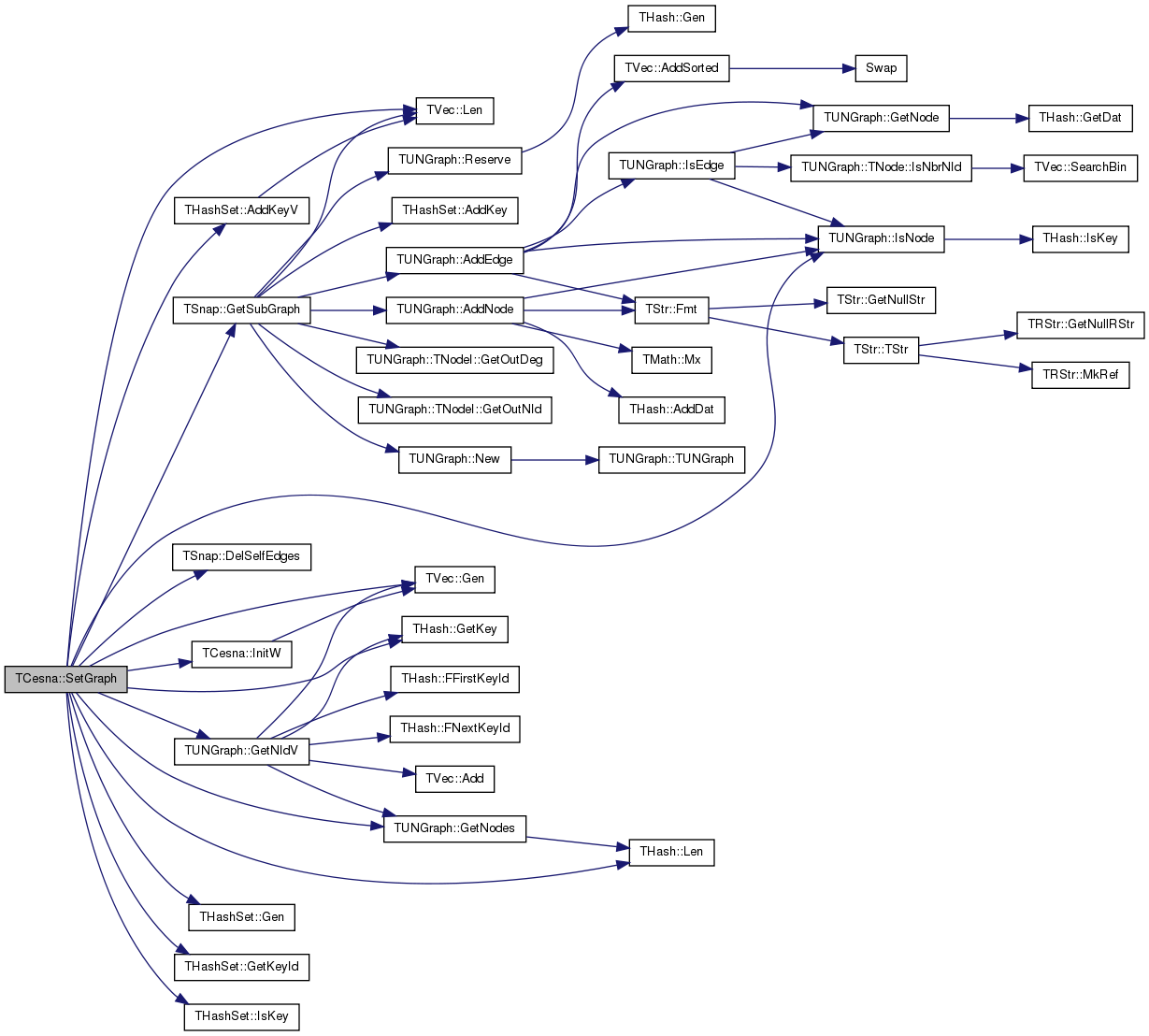

| void TCesna::SetHoldOut | ( | const double | HOFrac | ) | [inline] |
Definition at line 411 of file agmattr.h.
References G, GenHoldOutAttr(), TCesnaUtil::GenHoldOutPairs(), HOKIDSV, HOVIDSV, and Rnd.
{
TVec<TIntSet> HoldOut;
TCesnaUtil::GenHoldOutPairs(G, HoldOut, HOFrac, Rnd);
GenHoldOutAttr(HOFrac, HOKIDSV);
HOVIDSV = HoldOut;
}
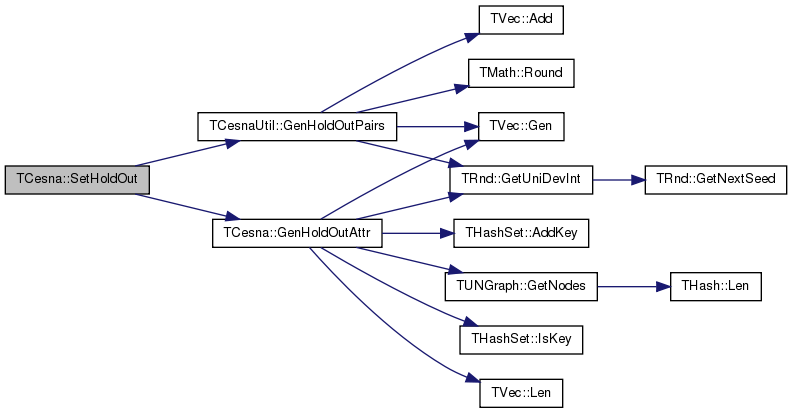
| void TCesna::SetLassoCoef | ( | const double | _LassoCoef | ) | [inline] |
| void TCesna::SetRegCoef | ( | const double | _RegCoef | ) | [inline] |
| void TCesna::SetW | ( | TVec< TFltV > & | _W | ) | [inline] |
| void TCesna::SetWeightAttr | ( | const double | _WeightAttr | ) | [inline] |
Definition at line 315 of file agmattr.h.
References IAssert, and WeightAttr.
{ IAssert (_WeightAttr <= 1.0 && _WeightAttr >= 0.0); WeightAttr = _WeightAttr; }
| double TCesna::Sigmoid | ( | const double | X | ) | [inline] |
Definition at line 629 of file agmattr.h.
Referenced by PredictAttrK().
{
return 1.0 / ( 1.0 + exp(-X));
}

| double TCesna::Sum | ( | const TIntFltH & | UV | ) | [inline] |
Definition at line 606 of file agmattr.h.
References THash< TKey, TDat, THashFunc >::BegI(), and THash< TKey, TDat, THashFunc >::EndI().
Referenced by LikelihoodForRow(), and LikelihoodGraph().
{
double N = 0.0;
for (TIntFltH::TIter HI = UV.BegI(); HI < UV.EndI(); HI++) {
N += HI.GetDat();
}
return N;
}


TInt TCesna::Attrs [private] |
Definition at line 249 of file agmattr.h.
Referenced by FindComs(), GenHoldOutAttr(), GetAttrs(), GetCmtyVV(), GetPositiveW(), GradientForRow(), InitW(), LikelihoodAttr(), LikelihoodForRow(), LikelihoodHoldOut(), Load(), MLEGradAscent(), MLEGradAscentParallel(), Save(), SetAttrHoldOutForOneNode(), and SetGraph().
Definition at line 266 of file agmattr.h.
Referenced by SetGraph().
Definition at line 247 of file agmattr.h.
Referenced by AddCom(), DelCom(), DotProduct(), GenHoldOutAttr(), GetCmtyVV(), GetCom(), GetComFromNID(), GradientForRow(), GradientForWK(), Likelihood(), LikelihoodAttr(), LikelihoodAttrKForRow(), LikelihoodForRow(), LikelihoodForWK(), LikelihoodGraph(), Load(), MLEGradAscent(), MLEGradAscentParallel(), NeighborComInit(), PredictAttrK(), Prediction(), RandomInit(), Save(), and SetCmtyVV().
Definition at line 245 of file agmattr.h.
Referenced by FindComs(), GenHoldOutAttr(), GetCmtyVV(), GetCmtyVVUnSorted(), GradientForRow(), LikelihoodForRow(), LikelihoodHoldOut(), Load(), MLEGradAscent(), MLEGradAscentParallel(), NeighborComInit(), RandomInit(), Save(), SetCmtyVV(), SetGraph(), SetHoldOut(), and TCesna().
TVec<TIntSet> TCesna::HOKIDSV [private] |
Definition at line 256 of file agmattr.h.
Referenced by FindComs(), GradientForRow(), GradientForWK(), LikelihoodAttr(), LikelihoodForRow(), LikelihoodForWK(), LikelihoodHoldOut(), Load(), Save(), SetAttrHoldOut(), SetGraph(), and SetHoldOut().
TVec<TIntSet> TCesna::HOVIDSV [private] |
Definition at line 255 of file agmattr.h.
Referenced by FindComs(), GradientForRow(), LikelihoodForRow(), LikelihoodHoldOut(), Load(), MLEGradAscentParallel(), Save(), SetGraph(), and SetHoldOut().
Definition at line 263 of file agmattr.h.
Referenced by GetLassoCoef(), GradientForWK(), LikelihoodForWK(), Load(), Save(), and SetLassoCoef().
Definition at line 259 of file agmattr.h.
Referenced by GetStepSizeByLineSearch(), Load(), and Save().
Definition at line 261 of file agmattr.h.
Referenced by GetStepSizeByLineSearchForWK(), Load(), MLEGradAscent(), MLEGradAscentParallel(), and Save().
Definition at line 258 of file agmattr.h.
Referenced by GetStepSizeByLineSearch(), Load(), and Save().
Definition at line 260 of file agmattr.h.
Referenced by GetStepSizeByLineSearchForWK(), Load(), MLEGradAscent(), MLEGradAscentParallel(), and Save().
Definition at line 262 of file agmattr.h.
Referenced by GradientForRow(), LikelihoodForRow(), LikelihoodHoldOut(), Load(), Save(), and SetGraph().
TIntSet TCesna::NIDToIdx [private] |
Definition at line 251 of file agmattr.h.
Referenced by DisplayAttrs(), GetCmtyVV(), GetCmtyVVUnSorted(), GetComFromNID(), Load(), Save(), SetAttrHoldOut(), SetCmtyVV(), and SetGraph().
TInt TCesna::NumComs [private] |
Definition at line 254 of file agmattr.h.
Referenced by GetCmtyVV(), GetCmtyVVUnSorted(), GetNumComs(), GetPositiveW(), GetStepSizeByLineSearchForWK(), GradientForWK(), InitW(), Load(), MLEGradAscent(), MLEGradAscentParallel(), NeighborComInit(), RandomInit(), Save(), and SetCmtyVV().
Definition at line 265 of file agmattr.h.
Referenced by Load(), Prediction(), Save(), and SetGraph().
TFlt TCesna::RegCoef [private] |
Definition at line 252 of file agmattr.h.
Referenced by GetRegCoef(), GradientForRow(), LikelihoodForRow(), LikelihoodGraph(), Load(), Save(), and SetRegCoef().
TRnd TCesna::Rnd [private] |
Definition at line 250 of file agmattr.h.
Referenced by FindComs(), GenHoldOutAttr(), MLEGradAscent(), MLEGradAscentParallel(), NeighborComInit(), RandomInit(), and SetHoldOut().
TFltV TCesna::SumFV [private] |
Definition at line 253 of file agmattr.h.
Referenced by AddCom(), DelCom(), GetCmtyVV(), GradientForRow(), LikelihoodForRow(), Load(), MLEGradAscentParallel(), NeighborComInit(), RandomInit(), Save(), and SetCmtyVV().
Definition at line 248 of file agmattr.h.
Referenced by GetStepSizeByLineSearchForWK(), GetW(), GradientForRow(), InitW(), LikelihoodAttr(), LikelihoodAttrKForRow(), LikelihoodForWK(), Load(), MLEGradAscent(), MLEGradAscentParallel(), PredictAttrK(), Save(), and SetW().
Definition at line 264 of file agmattr.h.
Referenced by FindComs(), GetWeightAttr(), GradientForRow(), LikelihoodForRow(), LikelihoodGraph(), LikelihoodHoldOut(), and SetWeightAttr().
Definition at line 246 of file agmattr.h.
Referenced by DisplayAttrs(), GetAttr(), Load(), Save(), and SetGraph().